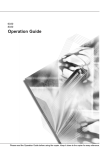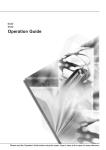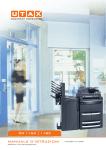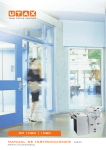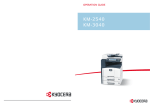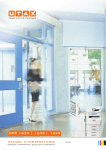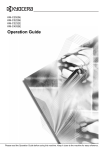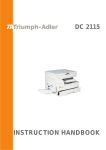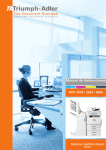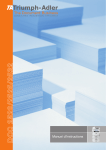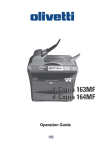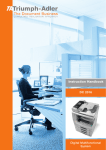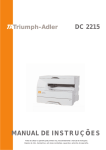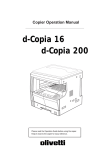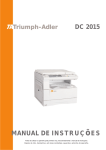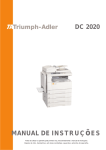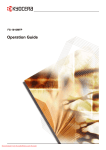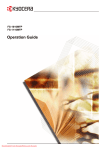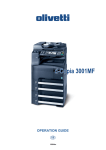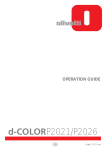Download User Guide - sbmonline.co.uk
Transcript
d-Copia 600
d-Copia 800
Operation Guide
PUBLICATION ISSUED BY:
Olivetti S.p.A.
Gruppo Telecom Italia
Via Jervis, 77 - 10015 Ivrea (ITALY)
www.olivetti.com
Copyright © 2006, Olivetti
All rights reserved
The
mark affixed to the product certifies that
the product satisfies the basic quality
requirements.
The manufacturer reserves the right to carry out modifications to the product described in this manual at any time
and without any notice.
ENERGY STAR is a U.S. registered mark.
The ENERGY STAR program is an energy reduction plan introduced by theUnited States Environmental Protection
Agency in response to environmental issues and for the purpose of advancing the development and utilization of
more energy efficient office equipment.
Your attention is drawn to the following actions which could compromise the conformity attested to above, as well
as the characteristics of the product:
• incorrect electrical power supply;
• incorrect installation, incorrect or improper use or use not in compliance with the warnings provided in the
User’s Manual supplied with the product;
• replacement of original components or accessories with others of a type not approved by the manufacturer, or
performed by unauthorised personnel.
All rights reserved. No part of this material may be reproduced or transmitted in any
form or by any means, electronic or mechanical, including photocopying, recording or
by any information storage and retrieval system, without permission in writing from
the Publisher.
Take Advantage of Advanced Functions
For information on basic copying, refer to Chapter 3 of the Operation Guide.
Selecting Image Quality
Adjusting Exposure
Auto Zoom
Enjoy crisp, high-quality copies, even Freely adjustable copy exposure
of photographs.
level.
Reduce or enlarge original images to
fit your selected paper size.
11 × 17": 129 %
8 1/2 × 11"
A3: 141 %
5 1/2 × 8 1/2": 64 %
A4
A5: 70 %
Manual Zoom
Preset Zoom
XY Zoom
Reduce or enlarge original images by One-touch selection of
25 to 400 % (25-200 % with the
magnifications.
document processor).
25 %
400 %
Select vertical and horizontal
magnification individually.
50%
64%
77%
78%
121%
129%
154%
200%
70%
75%
90%
106%
127%
141%
200%
Height
Width
Duplex Mode
Split Mode
Sort Mode
Create two-sided copies
automatically from any kind of
original.
Copy double-sided or two-page
originals onto separate sheets
automatically.
Make separate sets in the quantity of
your choice.
5
1
4
2
3
2
1
2
5
1
3
3
3
3
2
2
4
1
1
1
2
3
2
2
1
1
1
2
2
1
i
Read more about these sophisticated functions in Chapter 1 of the Advanced Operation Guide.
Auto Paper Selection
Offset Mode
Combine Mode
Automatic selection of paper to
match the original.
Handy option to stack sets in
alternating orientations.
Combine two or four originals on a
single page.
3
2
1
3
2
1
3
2
1
3
2
1
Margin Mode
Centering Originals
Border Erase
Set up blank margin or gutter space
for your binding needs.
Customize output by centering the
image on the page.
Eliminate unnecessary borders on
the original for cleaner output.
Page Numbering
Cover Mode
Form Overlay
Print sequential page numbers on the Use a distinctive front and/or back
copies.
cover.
Copy images from separate originals
together onto one sheet.
A
A
B
3
C
D
1
D
E
-1-
E
2
4
C
2
B
1
-2-3-4-5-
Booklet from Sheets
Booklets from Booklets
Memo Mode
Create booklets from separate
originals.
Reproduce booklets just as they are.
Add space for notes next to copied
images.
ii
Batch Scanning
Proof Mode
Repeat Copy
Copy high-volume originals in a
single copy job.
Copy a test sheet before a
high-volume job.
Produce more copies as needed after
making the initial copies.
3
2
1
200
100
1
1
3
2
1
3
2
1
Backing Sheets for Transparencies Auto Rotation
EcoPrint (Economy Printing) Mode
Use paper as backing sheets when
Automatically match the orientation of Use toner more efficiently as
printing transparencies for projectors. originals.
necessary.
Inverted Copying
Mirror Image
Invert both black and white and color Create mirror images of originals.
images.
Multi-Page Forms
Auto Selection Mode
Easily handle originals of different
sizes.
Programmed Copying
Great for bound originals made up of Store commonly used settings.
several sheets.
iii
Programming Multi-Part Jobs
Simply specify your series of special
copying needs-such as cover pages,
internal cover pages...
and zooming or border erase for
particular pages...
load the originals, and voila!
Automated copying of your detailed
jobs.
7
7
8
6
1
2
3
4
8
5
5
5
6
3
4
3
4
1
2
1
2
Read more about these handy document/output management functions in Chapter 2 of the Advanced Operation
Guide.
Form Box
Shared Data Box
Add and manage graphics for
compositing.
Easily store commonly used
documents...
Synergy Print Box
Just add common documents...
to produce them later as needed
without the original.
Output Management
to make them instantly available later Control and modify the copying order
in combination with other copying
of originals
jobs.
1
2
3
4
iv
1
4
3
2
Features for Easier Copying
Job Accounting Mode: Refer to
Weekly Timer: Refer to Chapter 3 of
Chapter 3 of the Advanced Operation the Advanced Operation Guide.
Guide.
Auto Power on/off.
Use department codes to manage
total copy volume.
Language Setting: Refer to
Selecting the Language on
page 2-20.
Choose the correct message display
language.
English
OFF
A
B
Deutsch
ON
C
Read about our full line of useful Optional Equipment on page 4-1.
Side Feeder
Document Finisher
(When equipped with a multi-job tray
and folding unit)
Key Counter
Printer Kit
Scanner Kit
Security Kit
v
vi
Legal and Safety Information
Please read this information before using your copier. This chapter provides information on the
following topics:
•
Legal Information...viii
•
Energy Star Program...ix
•
Safety Conventions in This Guide...x
•
Caution Labels...xii
•
Installation Precautions...xiii
•
Precautions for Use...xiv
vii
Legal Information
Notice
The information in this guide is subject to change without notification. Additional pages may be
inserted in future editions. The user is asked to excuse any technical inaccuracies or
typographical errors in the present edition.
No responsibility is assumed if accidents occur while the user is following the instructions in this
guide. No responsibility is assumed for defects in the printer’s firmware (contents of its read-only
memory).
This guide, any copyrightable subject matter sold or provided with or in connection with the sale
of the machine, are protected by copyright. All rights are reserved. Copying or other
reproduction of all or part of this guide, any copyrightable subject matter without the prior written
consent of Olivetti S.p.a, is prohibited. Any copies made of all or part of this guide,
any copyrightable subject must contain the same copyright notice as the material from which the
copying is done.
Legal Restriction On Copying
viii
•
It may be prohibited to copy copyrighted material without permission of the copyright owner.
•
It is prohibited under any circumstances to copy domestic or foreign currencies.
•
Copying other items may be prohibited.
Energy Star Program
We have determined as a participating company in the International Energy Star Program that
this product is compliant with the standards laid out in the International Energy Star Program.
About the International Energy Star Program
International Energy Star Program has as its basic goals the promotion of efficient energy use
and the reduction of the environmental pollution that accompanies energy consumption by
promoting the manufacture and sale of products that fulfill program standards.
International Energy Star Program standards require that copies come equipped with a Low
Power Mode where energy consumption is reduced after a certain amount of time elapses since
the device was last used, as well as an Off Mode where the device automatically turns itself off
after there is no activity within a set amount of time. When the copier includes printer and fax
functions, the printer and fax must enter a Low Power Mode where power consumption is
automatically reduced after a certain amount of time elapses since they were last used, and they
must also support a Sleep Mode where power consumption is reduced to a minimum when
there is no activity within a set amount of time. This product is equipped with the following
features as a result of its compliance with International Energy Star Program standards.
Low Power Mode
The device automatically enters Low Power Mode when 15 minutes have passed since the
device was last used. The amount of time of no activity that must pass before Low Power Mode
is activated may be lengthened. Refer to Low-Power Mode on page 3-19 for more information.
Off Mode
The device automatically enters Off Mode when 90 minutes have passed since the device was
last used. The amount of time of no activity that must pass before Off Mode is activated may be
lengthened. For more information refer to Sleep Mode on page 3-20.
Sleep Mode (If the copier has printer and/or facsimile function)
The device automatically enters Sleep Mode when 90 minutes have passed since the device
was last used. The amount of time of no activity that must pass before Sleep Mode is activated
may be lengthened. For more information refer to Sleep Mode on page 3-20.
Automatic 2-Sided Copy Function
The Energy Star Program encourages the use of 2-sided copying which reduces the load on the
environment and this device includes 2-sided copying as a standard function. For example, by
copying two 1-sided originals onto a single sheet of paper as a 2-sided copy, it is possible to
lower the amount of paper used. For more information refer to Duplex Mode on page 3-11.
Paper Recycling
The Energy Star Program encourages the use of environmentally friendly recycled paper. Your
sales or service representative can provide information about recommended paper types.
ix
Safety Conventions in This Guide
Please read this Operation Guide before using the copier. Keep it close to the copier for
easy reference.
The sections of this guide and parts of the copier marked with symbols are safety warnings
meant to protect the user, other individuals and surrounding objects, and ensure correct and
safe usage of the copier. The symbols and their meanings are indicated below.
DANGER: Indicates that serious injury or even death will very possibly result
from insufficient attention to or incorrect compliance with the related points.
WARNING: Indicates that serious injury or even death may result from
insufficient attention to or incorrect compliance with the related points.
CAUTION: Indicates that personal injury or mechanical damage may result from
insufficient attention to or incorrect compliance with the related points.
Symbols
The
symbol indicates that the related section includes safety warnings. Specific points of
attention are indicated inside the symbol.
....
[General warning]
....
[Warning of danger of electrical shock]
....
[Warning of high temperature]
The
symbol indicates that the related section includes information on prohibited actions.
Specifics of the prohibited action are indicated inside the symbol.
x
....
[Warning of prohibited action]
....
[Disassembly prohibited]
The z symbol indicates that the related section includes information on actions which must be
performed. Specifics of the required action are indicated inside the symbol.
....
[Alert of required action]
....
[Remove the power plug from the outlet]
....
[Always connect the machine to an outlet with a ground connection]
Please contact your service representative to order a replacement if the safety warnings in this
Operation Guide are illegible or if the guide itself is missing. (fee required)
xi
Caution Labels
Caution labels have been attached to the copier at the following locations for safety purposes.
Be sufficiently careful to avoid fire or electric shock when removing a paper jam or when
replacing toner.
Label 1, 2
Label 8, 9
High temperature inside. Do not
touch parts in this area, because
there is a danger of getting burned.
Do not touch the support area for the document
processor as there is a danger that your fingers
or other objects may become caught or pinched,
and this can result in injury.
Label 3
High voltage inside. Never touch parts
in this area, because there is a danger
of electric shock.
Label 4, 10
High temperature inside. Do not touch
parts in this area, because there is a
danger of getting burned.
Label 5, 6, 7
High temperature inside. Do not touch parts in this area, because there is a danger of getting burned.
NOTE: Do not remove these labels.
xii
Installation Precautions
Environment
Caution
Avoid placing the copier on or in locations which are unstable or not level. Such
locations may cause the copier to fall down or fall over. This type of situation presents
a danger of personal injury or damage to the copier.
Avoid locations with humidity or dust and dirt. If dust or dirt become attached to the
power plug, clean the plug to avoid the danger of fire or electrical shock.
Avoid locations near radiators, heaters, or other heat sources, or locations near
flammable items, to avoid the danger of fire.
To keep the copier cool and facilitate changing of parts and maintenance, allow
access space as shown below. Leave adequate space, especially around the rear
cover, to allow air to be properly ventilated out of the copier.
3 15/16"
10 cm
23 5/8"
60 cm
27 9/16"
70 cm
39 3/8"
100 cm
Always use the caster stoppers to stabilize the copier once it is in place to keep it
from moving and/or falling over and causing injury.
Other precautions
Adverse environmental conditions may affect the safe operation and performance of
the copier. Install in an air-conditioned room (recommended room temperature: around 73.4 °F
(23 °C), humidity: around 50 %) and avoid the following locations when selecting a site for the
copier.
•
Avoid locations near a window or with exposure to direct sunlight.
•
Avoid locations with vibrations.
•
Avoid locations with drastic temperature fluctuations.
•
Avoid locations with direct exposure to hot or cold air.
•
Avoid poorly ventilated locations.
xiii
If the floor is delicate against casters, when this product is moved after installation, the floor
material may be damaged.
During copying, some ozone is released, but the amount does not cause any ill effect to one’s
health. If, however, the copier is used over a long period of time in a poorly ventilated room or
when making an extremely large number of copies, the smell may become unpleasant. To
maintain the appropriate environment for copy work, it is suggested that the room be properly
ventilated.
Power supply/Grounding the copier
Warning
Do not use a power supply with a voltage other than that specified. Avoid multiple
connections in the same outlet. These types of situations present a danger of fire or
electrical shock.
Plug the power cord securely into the outlet. If metallic objects come in contact with
the prongs on the plug, it may cause a fire or electric shock.
Always connect the copier to an outlet with a ground connection to avoid the danger
of fire or electrical shock in case of an electric short. If an earth connection is not
possible, contact your service representative.
Other precautions
Connect the power plug to the closest outlet possible to the copier.
The power supply cord is used as the main disconnect device. Ensure that the socket/outlet is
located/installed near the equipment and is easily accessible.
Handling of plastic bags
Warning
Keep the plastic bags that are used with the copier away from children. The plastic
may cling to their nose and mouth causing suffocation.
Precautions for Use
Cautions when using the copier
Warning
Do not place metallic objects or containers with water (flower vases, flower pots,
cups, etc.) on or near the copier. This of situation presents a danger of fire or
electrical shock should they fall inside.
Do not remove any of the covers from the copier as there is a danger of electrical
shock from high voltage parts inside the copier.
xiv
Do not damage, break or attempt to repair the power cord. Do not place heavy
objects on the cord, pull it, bend it unnecessarily or cause any other type of damage.
These types of situations present a danger of fire or electrical shock.
Never attempt to repair or disassemble the copier or its parts as there is a danger of
fire, electrical shock or damage to the laser. If the laser beam escapes, there is a
danger of it causing blindness.
If the copier becomes excessively hot, smoke appears from the copier, there is an
odd smell, or any other abnormal situation occurs, there is a danger of fire or
electrical shock. Turn the main power switch off ({ position) immediately, be
absolutely certain to remove the power plug from the outlet and then contact your
service representative.
If anything harmful (paper clips, water, other fluids, etc.) falls into the copier, turn the
main power switch off ({ position) immediately. Next, be absolutely certain to remove
the power plug from the outlet to avoid the danger of fire or electrical shock. Then
contact your service representative.
Do not remove or connect the power plug with wet hands, as there is a danger of
electrical shock.
Always contact your service representative for maintenance or repair of internal parts.
Caution
Do not pull the power cord when removing it from the outlet. If the power cord is
pulled, the wires may become broken and there is a danger of fire or electrical shock.
(Always grasp the power plug when removing the power cord from the outlet.)
Always remove the power plug from the outlet when moving the copier. If the power
cord is damaged, there is a danger of fire or electrical shock.
If the copier will not be used for a short period of time (overnight, etc.), turn the main
switch off ({). If it will not be used for an extended period of time (vacations, etc.),
remove the power plug from the outlet for safety purposes during the time the copier
is not in use.
Always hold the designated parts only when lifting or moving the copier.
For safety purposes, always remove the power plug from the outlet when performing
cleaning operations.
If dust accumulates within the copier, there is a danger of fire or other trouble. It is
therefore recommended that you consult with your service representative in regard to
cleaning of internal parts. This is particularly effective if accomplished prior to
seasons of high humidity. Consult with your service representative in regard to the
cost of cleaning the internal parts of the copier.
Do not leave the document processor open as there is a danger of personal injury.
Other precautions
Do not place heavy objects on the copier or cause other damage to the copier.
Do not open the front cover, turn off the main power switch, or pull out the power plug during
copying.
xv
When lifting or moving the copier, contact your service representative.
Do not touch electrical parts, such as connectors or printed circuit boards. They could be
damaged by static electricity.
Do not attempt to perform any operations not explained in this handbook.
Caution: Use of controls or adjustments or performance of procedures other than those
specified herein may result in hazardous radiation exposure.
Do not look directly at the light from the scanning lamp as it may cause your eyes to feel tired or
painful.
This copier comes equipped with an HDD (hard disk). Do not attempt to move the copier while
the power is still on; Since any resulting shock or vibration may cause damage to the hard disk,
be sure to turn off the power before attempting to move the copier.
Cautions when handling consumables
Caution
Do not attempt to incinerate the toner container or the waste toner box. Dangerous
sparks may cause burns.
Keep the toner container and the waste toner box out of the reach of children.
If toner happens to spill from the toner container or the waste toner box, avoid
inhalation and ingestion, as well as contact with your eyes and skin.
•
If you do happen to inhale toner, move to a place with fresh air and gargle
thoroughly with a large amount of water. If coughing develops, contact a
physician.
•
If you do happen to ingest toner, rinse your mouth out with water and drink 1 or 2 cups of
water to dilute the contents of your stomach. If necessary, contact a physician.
•
If you do happen to get toner in your eyes, flush them thoroughly with water. If there is any
remaining tenderness, contact a physician.
•
If toner does happen to get on your skin, wash with soap and water.
Do not attempt to force open or destroy the toner container or the waste toner box.
Other precautions
After use, always dispose of the toner container and the waste toner box in
accordance with Federal, State and Local rules and regulations.
If the copier will not be used for an extended period of time, remove the paper from the cassette
and the MP tray (multi-purpose tray), return it to its original package and reseal it.
Don’t store the unit in a place exposed to:
xvi
•
Direct sunlight
•
High or rapidly variable temperature or humidity (limit: 104 °F or 40 °C)
Laser Safety (Europe)
Laser radiation could be hazardous to the human body. For this reason, laser radiation emitted
inside this machine is hermetically sealed within the protective housing and external cover. In
the normal operation of the product by user, no radiation can leak from the machine.
This machine is classified as Class 1 laser product under IEC 60825.
Caution: Performance of procedures other than those specified in this manual may result in
hazardous radiation exposure.
These labels are attached to the laser scanner unit inside the machine and are not in a user
access area.
The label shown below is attached on the left side of the machine.
xvii
Safety Instructions Regarding the Disconnection of Power
Caution: The power plug is the main isolation device! Other switches on the equipment are only
functional switches and are not suitable for isolating the equipment from the power source.
VORSICHT: Der Netzstecker ist die Hauptisoliervorrichtung! Die anderen Schalter auf dem
Gerät sind nur Funktionsschalter und können nicht verwendet werden, um den Stromfluß im
Gerät zu unterbrechen.
DECLARATION OF CONFORMITY
TO
89/336/EEC, 73/23/EEC and 93/68/EEC
We declare under our sole responsibility that the product to which
this declaration relates is in conformity with the following specifications.
xviii
Limits and methods of measurement for immunity
characteristics of information technology equipment
EN55024
Limits and methods of measurement for radio interference
characteristics of information technology equipment
EN55022 Class B
Limits for harmonic currents emissions
for equipment input current 16A per phase
EN61000-3-2
Limitation of voltage fluctuations and flicker in low-voltage
supply systems for equipment with rated current 16A
EN61000-3-3
Safety of information technology equipment,
including electrical equipment
EN60950
Radiation Safety of laser products, equipment classification,
requirements and user’s guide
EN60825-1
SAFETY OF LASER BEAM (USA)
1. Safety of laser beam
This copier has been certified by the manufacturer to Class 1 level under the radiation
performance standards established by the U.S.DHHS (Department of Health and Human
Services) in 1968. This indicates that the product is safe to use during normal operation and
maintenance. The laser optical system, enclosed in a protective housing and sealed within the
external covers, never permits the laser beam to escape.
2. The CDRH Act
A laser-product-related act was implemented on Aug. 2, 1976, by the Center for Devices and
Radiological Health (CDRH) of the U.S. Food and Drug Administration (FDA). This act prohibits
the sale of laser products in the U.S. without certification, and applies to laser products
manufactured after Aug. 1, 1976. The label shown below indicates compliance with the CDRH
regulations and must be attached to laser products marketed in the United States. On this
copier, the label is on the left.
3. Optical unit
When checking the optical unit, avoid direct exposure to the laser beam, which is invisible.
Shown at below is the label located on the cover of the optical unit.
4. Maintenance
For safety of the service personnel, follow the maintenance instructions in the other section of
this manual.
5. Safety switch
The power to the laser unit is cut off when the upper front cover is opened.
xix
Safety Instructions Regarding the Disconnection of Power
Caution: The power plug is the main isolation device! Other switches on the equipment are only
functional switches and are not suitable for isolating the equipment from the power source.
Attention: Le débranchement de la fiche secteur est le seul moyen de mettre l’appareil hors
tension. Les interrupteurs sur l’appareil ne sont que des interrupteurs de fonctionnement: ils ne
mettent pas l’appareil hors tension.
WARNING
This equipment has been tested and found to comply with the limits for a Class B digital device, pursuant to
Part 15 of the FCC Rules. These limits are designed to provide reasonable protection against harmful
interference in a residential installation. This equipment generates, uses and can radiate radio frequency
energy and, if not installed and used in accordance with the instructions, may cause harmful interference to
radio communications. However, there is no guarantee that interference will not occur in a particular
installation. If this equipment does cause harmful interference to radio or television reception, which can be
determined by turning the equipment off and on, the user is encouraged to try to correct the interference by
one or more of the following measures:
•
Reorient or relocate the receiving antenna.
•
Increase the separation between the equipment and receiver.
•
Connect the equipment into an outlet on a circuit different from that to which the receiver is connected.
•
Consult the dealer or an experienced radio/TV technician for help.
CAUTION — The changes or modifications not expressly approved by the party responsible for compliance
could void the user’s authority to operate the equipment.
* The above warning is valid only in the United States of America.
MERCURY WARNING
THE LAMP(S) INSIDE THIS PRODUCT CONTAIN MERCURY AND MUST BE RECYCLED OR
DISPOSED OF ACCORDING TO LOCAL, STATE OR FEDERAL LAWS.
xx
Introduction
This Operation Guide contains the following chapters:
1 Part Names
Identifies copier parts and operation panel keys.
2 Preparing to Copy
Explains how to load paper and originals.
3 Basic Operation
Describes the procedures for basic copying.
4 Optional Equipment
Introduces the convenient optional equipment available for this copier.
5 Maintenance
Describes cleaning and toner replacement.
6 Troubleshooting
Explains how to handle error messages, paper jams, and other problems.
Appendix
Lists the copier specifications.
xxi
Guides Included
The following guides are included with this copier. Refer to the proper guide for your needs.
Operation Guide (This Guide)
Describes how to load paper, basic copier operations, and troubleshooting.
Advanced Operation Guide
Covers copying details in depth as well as default settings.
Conventions in This Guide
The following conventions are used depending on the nature of the description.
Convention Description
Example
Bold
Indicates operation panel keys.
Press the Start key.
[Regular]
Indicates touch panel keys.
Press [Basic].
Italic
Indicates touch panel messages.
Ready to copy is displayed.
NOTE
Indicates supplemental information or
operations for reference.
NOTE: -
IMPORTANT Indicates items that are required or
prohibited so as to avoid problems.
xxii
IMPORTANT: -
Contents
Take Advantage of Advanced Functions ...................................................................................... i
Legal and Safety Information ........................................................................................................................ vii
Legal Information ......................................................................................................................viii
Energy Star Program .................................................................................................................. ix
Safety Conventions in This Guide ............................................................................................... x
Caution Labels .......................................................................................................................... xii
Installation Precautions .............................................................................................................xiii
Precautions for Use .................................................................................................................. xiv
Introduction .................................................................................................................................................xxi
Guides Included ......................................................................................................................xxii
Conventions in This Guide ......................................................................................................xxii
1
Part Names ..................................................................................................... 1-1
Copier .......................................................................................................................................1-2
Document Processor ................................................................................................................1-4
Internal Parts ............................................................................................................................1-5
Operation Panel .......................................................................................................................1-6
Touch Panel .............................................................................................................................1-7
2
Preparing to Copy .......................................................................................... 2-1
Loading Paper ..........................................................................................................................2-2
Specifying Paper Type and Size to the Cassettes and MP Tray ..............................................2-8
Loading Originals ...................................................................................................................2-16
Selecting the Language .........................................................................................................2-20
3
Basic Operation ............................................................................................. 3-1
Basic Copying Procedures .......................................................................................................3-2
Selecting Image Quality ...........................................................................................................3-4
Adjusting Exposure ..................................................................................................................3-5
Reducing/Enlarging ..................................................................................................................3-6
Duplex Mode ..........................................................................................................................3-11
Split Mode ..............................................................................................................................3-14
Sort Mode ...............................................................................................................................3-16
Interrupt Mode ........................................................................................................................3-17
Job Reservation .....................................................................................................................3-18
Low-Power Mode ...................................................................................................................3-19
Sleep Mode ............................................................................................................................3-20
4
Optional Equipment ....................................................................................... 4-1
Overview of Optional Equipment ..............................................................................................4-2
Side Feeder ..............................................................................................................................4-3
Document Finisher ...................................................................................................................4-3
Key Counter .............................................................................................................................4-3
Printer Kit .................................................................................................................................4-4
Scanner Kit ...............................................................................................................................4-4
Security Kit ...............................................................................................................................4-4
5
Maintenance ................................................................................................... 5-1
Cleaning the Copier .................................................................................................................5-2
Replacing Toner Container .......................................................................................................5-4
6
Troubleshooting ............................................................................................. 6-1
Solving Malfunctions ................................................................................................................6-2
Responding to Error Messages ................................................................................................6-4
xxiii
Clearing Paper Jams ............................................................................................................... 6-9
Appendix ..................................................................................................... Appendix-1
Specifications ............................................................................................................. Appendix-2
Index ................................................................................................................... Index-1
xxiv
1
Part Names
This chapter identifies copier parts and operation panel keys.
•
Copier...1-2
•
Operation Panel...1-6
•
Touch Panel...1-7
1-1
Part Names
Copier
1
2
3
8
10
9
5
12
4
11
6
7
1
Operation Panel
2
Operation Panel Lock Lever
3
Document Processor
4
Cassette 1
5
Cassette 2
6
Cassette 3
7
Cassette 4
8
MP Tray (multi-purpose tray)
9
Paper Width Guides
10 MP Tray Extension
11 Right Cover
12 Handles
1-2
Part Names
13
15
14
16
17
19
18
20
21
13 Main Power Switch
14 Main Power Switch Cover
15 Document Processor Bottom Cover
16 Original Size Indicator Plates
17 Platen
18 Front Cover
19 Output Tray (Option)
20 Handles
21 Power Cord
1-3
Part Names
Document Processor
23
24
25
22
23
26
27
28
29
22 Original Table
23 Original Width Guides
24 Cleaning Cloth Compartment
25 Original Loaded Indicator
26 Document Processor Top Cover
27 Ejection Guide
28 Document Processor Angle Adjustment Lever
29 Original Eject Table
1-4
Part Names
Internal Parts
31
30
37
32
33
34
35
36
38
39
41
40
30 Toner Container
31 Toner Container Release Lever
32 Paper Conveyor
33 Knob A1
34 Lever A2
35 Knob A3
36 Duplex Unit
37 Paper Feeder
38 Paper Width Guides
39 Paper Width Adjusting Tab
40 Paper Length Guide
41 Paper Length Adjusting Tab
1-5
Part Names
Operation Panel
1
2
3
5
6
7
8
9
12
16
13
19
Set
11x8½"
100%
4 in 1
11x8½"
Plain
APS
MP tray
Plain
8½x11"
Plain
11x8½"
Plain
Basic
User choice
Auto %
Staple Off
100%
Auto
Exposure
Staple
Left Top
Reduce
/Enlarge
Exposure
Mode
Staple
/Punch
Function
4
Margin
Left
Sheet
Erase
Program
14
1
Brightness Adjustment Dial
2
Copy Key/Indicator
3
Printer Key/Indicator
4
Scanner Key/Indicator
5
Document Management Key/Indicator
6
Print Management Key/Indicator
7
Repeat Copy Key/Indicator
8
Job Build Key/Indicator
9
Auto Selection Key/Indicator
10 System Menu/Counter key
11 Job Accounting key
12 Interrupt Key/Indicator
13 Energy Saver Key/Indicator
14 Touch Panel
15 Numeric Keys
16 Reset Key
17 Stop/Clear Key
18 Start Key/Indicator
19 Power Key/Indicator
20 Main Power Indicator
1-6
11
Paper Size
Ready to copy.
11x8½"
Recycled
11x17"
Plain
10
15
17 18
20
Part Names
Touch Panel
1
[Basic] Screen
Press [Basic] to display
this screen.
Paper Size
Set
11x8½"
100%
Ready to copy.
4 in 1
11x8½"
Plain
11x8½"
Recycled
2
[User choice] Screen
Press [User choice] to
display this screen.
APS
11x17"
Plain
8½x11"
Plain
MP tray
Plain
Basic
User choice
11x8½"
Plain
Auto %
Staple Off
100%
Auto
Exposure
Staple
Left Top
Reduce
/Enlarge
Exposure
Mode
Staple
/Punch
Function
Margin
Left
Sheet
Erase
Program
Paper Size
Set
11x8½"
100%
Ready to copy.
4 in 1
2 sided/
Separation
Orig.Image
Quality
Sort/
Offset
Margin/
Centering
Margin
Left
Border
Erase
Sheet
Erase
Combine
Basic
3
[Function] Screen
Press [Function] to
display this screen.
[Program] Screen
Press [Program] to
display this screen.
User choice
Booklet
Function
Cover
Mode
Select
Orig.Size
Program
Paper Size
Set
11x8½"
100%
Ready to copy.
Select
Paper
2 sided/
Separation
Select
Orig.Size
Combine
Exposure
Mode
Reduce
/Enlarge
Auto
Selection
Batch
Scanning
Up
Margin
Left
Orig.Image
Quality
Margin/
Centering
Page #
Form
Overlay
Down
Sheet
Erase
Sort/
Offset
Border
Erase
Cover
Mode
Booklet
Basic
4
Page #
User choice
Function
4 in 1
Program
Paper Size
Set
11x8½"
100%
Ready to copy.
Recall
Reg./Delete
4 in 1
Register
Margin
Left
Delete
Sheet
Erase
Change
Name
Basic
User choice
Function
Program
1-7
Part Names
1-8
2
Preparing to Copy
This chapter explains the preparations required before using the copier.
•
Loading Paper...2-2
•
Specifying Paper Type and Size to the Cassettes and MP Tray...2-8
•
Loading Originals...2-16
•
Selecting the Language...2-20
2-1
Preparing to Copy
Loading Paper
Load paper in the four cassettes, the MP tray and/or the optional side feeder. For details on the
types of paper supported, refer to Paper in the Appendix of the Advanced Operation Guide.
Before Loading Paper
When you open a new package of paper, follow the instructions as below to fan through the paper
prior to loading.
1
Holding the paper on both sides, bend the
edges downward so that the middle curves
upward.
2
Holding your thumbs in place toward the
center, unbend the paper so that the
bottom sheet is back at its original position.
Your thumbs should prevent the stack from
straightening out, forming a hill-like shape.
3
Fluff the paper, raising one hand and
lowering the other, then alternating. The
individual sheets are slightly lifted,
separated from each other.
4
Align the sheets by tapping the stack on a flat surface.
If the paper is curled or folded, straighten it before loading. Paper that is curled or folded may cause
paper jams.
IMPORTANT: If you copy onto used paper (paper already used for copying), do not use paper that
is stapled or clipped together. This may damage the copier or cause poor image quality.
If ejected copies are not flat or are stacked unevenly,
turn the paper in the cassette over and reload it.
Avoid exposing opened paper to high temperatures
and high humidity as dampness may cause copying
problems. Seal any remaining paper after loading the
MP tray or a cassette in its original package. If the
copier will not be used for a prolonged period, protect
all paper from humidity by removing from the cassettes
and sealing in the original package.
Loading Paper in Cassettes 1 and 2
Cassettes 1 and 2 support standard and recycled paper. Up to 1,500 sheets of standard paper
(80 g/m²) may be loaded in each cassette.
The cassettes support 11 × 8 1/2" or A4 paper.
IMPORTANT: Specify the type of paper loaded in the cassettes. Refer to Specifying the Paper Type
on page 2-9 for details.
1
2-2
Pull the cassette out toward you until it stops.
Preparing to Copy
2
Align the paper flush against the right side of the
cassette as you load it.
IMPORTANT: Before loading the paper, be sure that it
is not curled or folded. Paper that is curled or folded
may cause paper jams.
Ensure that the loaded paper does not exceed the
level indicated.
3
Gently push the cassette back in.
Loading Paper in Cassettes 3 and 4
Cassettes 3 and 4 support standard, recycled, and colored paper. Up to 500 sheets of standard
paper (80 g/m²) (or 525 sheets for standard paper of 75 g/m²) can be loaded in each cassette.
The following paper sizes are supported: 11 × 17", 8 1/2 × 14", 11 × 8 1/2", 8 1/2 × 11", 5 1/2 × 8 1/2",
8 1/2 × 13", 8 1/2 × 13 1/2", A3, B4, A4, A4R, B5, B5R, A5R, Folio, 8K and 16K.
IMPORTANT: After loading paper, be sure to specify the type and size of the paper loaded in the
cassettes on the operation panel. For further details, refer to Specifying the Paper Size on page 2-8
and Specifying the Paper Type on page 2-9.
1
Pull the cassette out toward you until it stops.
2
Using the paper length adjusting tab, move the plate to
fit the paper.
NOTE: Paper sizes are marked on the cassette.
2-3
Preparing to Copy
3
Holding the paper width adjusting tab both ends, move
the paper width guide to fit the paper.
NOTE: Paper sizes are marked on the cassette.
To switch between inch and metric paper sizes, slide
the size adjustment switch.
4
Holding the paper width adjustment tab both ends,
move the paper width guide to anywhere that the
paper size scale is not indicated.
2
Rotate the size adjustment switch (A) 90 degrees,
horizontal to vertical.
3
Slide the size adjustment lever (B) to upper (C) or
lower (I) position.
I: Inches
C: Metrics
4
Rotate the size adjustment switch 90 degrees, vertical to horizontal.
Align the paper flush against the right side of the
cassette as you load it.
IMPORTANT: Be sure that the paper length and width
guides rest securely against the paper. If there is a
gap, readjust the guides to fit the paper. The gap may
cause paper jam.
Before loading the paper, be sure that it is not curled
or folded. Paper that is curled or folded may cause
paper jams.
Ensure that the loaded paper does not exceed the
level indicated. Paper that exceeds the level indicated
may cause paper jam.
2-4
A
1
B
Preparing to Copy
5
Insert the appropriate paper size card in the slot to
indicate the size of the paper inside.
6
Gently push the cassette back in.
Loading Paper in the MP Tray
The MP tray supports special paper (45 to 200 g/m²) in addition to standard and recycled paper. Up
to 100 sheets of standard paper (80 g/m²) may be loaded in the MP tray.
The MP tray accepts paper sizes from 5 1/2 × 8 1/2" to 11 × 17" and from 16K, 8K, Folio, A6R, and
B6R to A3.
The capacity of the MP tray is as follows.
Paper Type
Capacity
Standard paper (80 g/m²)
100 sheets
Standard paper (120 g/m², 160 g/m², 200 g/m²) or
transparencies
25 sheets
IMPORTANT: After loading paper, be sure to specify the type and size of the paper loaded in the
MP tray on the operation panel. For further details, refer to Specifying the Paper Size to the MP Tray
on page 2-11 and Specifying the Paper Type to the MP Tray on page 2-14.
1
Open the MP tray.
For paper larger than 8 1/2 × 11" or A4R, pull out the
MP tray extension.
2-5
Preparing to Copy
2
Adjust the paper width guides to fit the width of the
paper.
3
Insert the paper along the paper width guides into the
tray until it stops.
Ensure that the paper width guides are flush against
the edges of the paper.
IMPORTANT: Before loading postcards and other
types of thick paper that may be curled, straighten out
the paper. The paper may not be fed depending on the
paper quality.
Only load the MP tray when you are using. Avoid
leaving paper in the MP tray.
Ensure that the loaded paper does not exceed the
level indicated. Exceeding the maximum level may
cause paper jam.
When loading envelopes, open the flap and keep the
printing side face-up. Insert envelopes against the guide with the flap on the right until they stop.
Loading Paper in the Optional Side Feeder
The optional side feeder has a capacity of 4,000 sheets of 11 × 8 1/2" (A4 or B5) standard paper
(80 g/m²).
IMPORTANT: After loading paper, be sure to specify the type and size of the paper loaded in the
side feeder on the operation panel. Refer to Specifying the Paper Type on page 2-9 for details.
1
Press the switch for the paper lifter on the right side of
the side feeder. The paper lifter inside of the side
feeder will drop to the bottom.
NOTE: When the side feeder runs out of paper, the
paper lifter will automatically descend to the bottom.
2-6
Preparing to Copy
2
Open the right cover.
NOTE: When the right cover is open, the paper lifter
will not descend if you press the switch for the paper
lifter.
It is easier to load new paper with the top cover open.
3
Align the paper flush against the left side in the back of
the feeder as you load it.
IMPORTANT: Before loading the paper, be sure that it
is not curled or folded. Paper that is curled or folded
may cause paper jams.
Ensure that the loaded paper does not exceed the
level indicated. Exceeding the maximum level may
cause paper jam.
4
Close the top and right covers of the side feeder.
2-7
Preparing to Copy
Specifying Paper Type and Size to the Cassettes and MP Tray
After loading paper in the cassettes 1 or 2 or the optional side feeder (cassette 5), specify the paper
type. Refer to Specifying the Paper Type on page 2-9 for details.
After loading paper in the cassettes 3 or 4, specify both the paper type and size. Refer to Specifying
the Paper Size below and Specifying the Paper Type on page 2-9.
After loading paper in the MP tray, specify both the paper type and size. Refer to Specifying the
Paper Size to the MP Tray on page 2-11 and Specifying the Paper Type to the MP Tray on
page 2-14.
Specifying the Paper Size
Specify the paper size when using the cassettes 3 and 4. For automatic detection of the paper size,
specify [Auto Detection] and select [Centimeter] or [Inch] as the unit.
The following paper sizes are available.
11 × 17", 8 1/2 × 14", 11 × 8 1/2", 8 1/2 × 11", 5 1/2 × 8 1/2", 8 1/2 × 13 1/2", 8 1/2 × 13" (Oficio 2), A3, B4,
A4, A4R, B5, B5R, A5R, Folio, 8K and 16K
1
Press the System Menu/Counter key.
2
Press [Machine Default].
System Menu / Counter
System Menu
Copy
Default
Machine
Default
3
Use the numeric keys to enter the
four-digit management code. By default,
the management code is 6000 for 60
cpm model and 8000 for 80 cpm model.
NOTE: When installing the optional
security kit, enter the eight-digit
management code. By default, the
management code is 60006000 for 60
cpm model and 80008000 for 80 cpm
model.
2-8
Document
Management
Enter the administrator number.
Language
Job
Accounting
MP tray
Setting
BOX
Management
Register
Orig. Size
Print
Report
Preparing to Copy
4
Press [S] or [T] to choose Paper size
[3rd drawer] (Paper size [3rd cassette])
or Paper size [4th drawer] (Paper size
[4th cassette]). Press [Change #] to
begin changing settings.
System Menu / Counter
Machine Default
Default menu
Auto drawer switching
Paper size (3rd drawer)
Paper size (4th drawer)
Paper type (1st drawer)
Paper type (2nd drawer)
Setting mode
On / All types of paper
11x17"
Auto/Inch
Plain
Recycled
Change #
System Menu
5
When [Auto Detection] is selected,
choose the unit of measurement. When
[Standard sizes] is selected, choose the
paper size.
Press [Close].
[Close]: Returns to the previous page by
holding the settings.
[Back]: Returns to the previous page by
canceling the settings.
Close
Back
Paper size (3rd drawer)
Select paper size.
A3
B4
5½x8 ½"
Auto
Detection
A4
B5
8½x13 ½"
Standard
sizes
A4
B5
8½x13"
A5
Folio
8K
System Menu
16K
- Machine Default
6
Press [Close].
7
Press [End]. The touch panel will return to the [Basic] screen.
Specifying the Paper Type
Specify the paper type when using the cassettes 1 to 5.
The following paper types are available.
Plain, Recycled, Preprinted, Bond, Color (Colour), Letterhead, Thick paper, High Quality and
Custom 1-8
1
Press the System Menu/Counter key.
2
Press [Machine Default].
System Menu / Counter
System Menu
Copy
Default
Machine
Default
Document
Management
Language
Job
Accounting
MP tray
Setting
BOX
Management
Register
Orig. Size
Print
Report
2-9
Preparing to Copy
3
Use the numeric keys to enter the
four-digit management code. By default,
the management code is 6000.
4
Press [S] or [T] to choose from Paper
type (1st drawer) (Paper type [1st
cassette]) through Paper type (5th
drawer) (Paper type [5th cassette]).
Press [Change #] to begin changing
settings.
NOTE: Paper type (5th drawer) (Paper
type [5th cassette]) is displayed when
installing the optional side feeder.
5
Select the paper type and press [Close].
Enter the administrator number.
System Menu / Counter
Machine Default
Default menu
Paper
Paper
Paper
Paper
Paper
size (4th drawer)
type (1st drawer)
type (2nd drawer)
type (3rd drawer)
type (4th drawer)
Setting mode
Auto/Inch
Plain
Recycled
Plain
Plain
Change #
System Menu
Paper type (1st drawer)
Back
Select and display paper type.
Thick
paper
Plain
Recycled
Color
Preprinted
Bond
System Menu
2-10
- Machine Default
6
Press [Close].
7
Press [End]. The touch panel will return to the [Basic] screen.
Letterhead
High
Quality
Custom 1
Custom
Custom 2
Custom
Custom 3
Custom
Custom 4
Custom
Preparing to Copy
Specifying the Paper Size to the MP Tray
Specify the paper size when using the MP tray.
Select the paper size from the followings.
Setting Method
Unit
Paper Sizes
Auto Detect
Inch
11 × 17", 8 1/2 × 14", 11 × 8 1/2", 8 1/2 × 11" and 5 1/2 × 8 1/2"
Centimeter
A3, B4, A4, A4R, B5, B5R, A5R, B6R, A6R and Folio
Other Standard Sizes
ISO B5, Envelope DL, Envelope C5, Envelope C4, Comm.
#10, Comm. #9, Monarch, Executive, OUFUKU (Return
postcard), YOUKEI 2, YOUKEI 4, 8 1/2 × 13 1/2", 8 1/2 × 13"
(Oficio 2), 8K and 16K
Input Size
Inch models
Vertical: 3 7/8 to 11 5/8" (in 1/8" increments)
Horizontal: 5 7/8 to 17" (in 1/8" increments)
Metric models
Vertical: 98 to 297 mm (in 1-mm increments)
Horizontal: 148 to 432 mm (in 1-mm increments)
Auto Detect
The paper size is automatically detected. Specify [Centimeter] or [Inch].
1
Press the System Menu/Counter key.
2
Press [MP tray Setting].
System Menu / Counter
System Menu
Copy
Default
Machine
Default
3
Press [Auto Detection].
Document
Management
Language
Job
Accounting
MP tray
Setting
BOX
Management
Register
Orig. Size
Print
Report
System Menu / Counter
Back
MP tray Setting
Paper Size
Unit
Auto
Detection
Centimeter
Input size
Inch
Paper Type
Plain
Others
Standard
4
Press [Centimeter] or [Inch].
5
Press [Close]. The touch panel will return to the [Basic] screen.
2-11
Preparing to Copy
Other Standard Sizes
Specify special standard sizes.
1
Press the System Menu/Counter key.
2
Press [MP tray Setting].
System Menu / Counter
System Menu
Copy
Default
Machine
Default
3
Press [Others Standard] and then
[Select size].
Document
Management
Language
Job
Accounting
MP tray
Setting
BOX
Management
Register
Orig. Size
Print
Report
System Menu / Counter
Back
MP tray Setting
Paper Size
Unit
Auto
Detection
Centimeter
Input size
Inch
Paper Type
Plain
Others
Standard
4
Select the paper size.
System Menu / Counter
Back
Select size
2-12
ISO B5
Comm.#10
OUFUKU
HAGAKI
8½x13"
Envelope
DL
Comm.#9
YOUKEI 2
8K
Envelope
C5
Envelope
C4
MO
YOUKEI 4
16K
EX
8½x13½"
5
Press [Close].
6
Press [Close]. The touch panel will return to the [Basic] screen.
Preparing to Copy
Input Size
Specify the required paper size.
1
Press the System Menu/Counter key.
2
Press [MP tray Setting].
System Menu / Counter
System Menu
Copy
Default
Machine
Default
3
Press [Input size].
Document
Management
Language
Job
Accounting
MP tray
Setting
BOX
Management
Register
Orig. Size
Print
Report
System Menu / Counter
Back
MP tray Setting
Paper Size
Unit
Auto
Detection
Centimeter
Input size
Inch
Paper Type
Plain
Others
Standard
4
Press [+] or [-] to specify the vertical
size. With the metric models, you may
enter the size directly using the numeric
keys by pressing [#-Keys].
System Menu / Counter
Back
MP tray Setting
(37 /8
Paper Size
Y
(57 /8
115/8)
31 5/16 "
Auto
Detection
X
17)
Paper Type
513/16 "
Plain
Input size
Others
Standard
The setting range is as follows.
Setting Range
Inch models
3 7/8 to 11 5/8" (in 1/8" increments)
Metric models
98 to 297 mm (in 1-mm increments)
2-13
Preparing to Copy
5
Press [+] or [-] to specify the horizontal
size. With the metric models, you may
enter the size directly using the numeric
keys by pressing [#-Keys].
System Menu / Counter
Back
MP tray Setting
(37 /8
Paper Size
Y
(57 /8
115/8)
315/16 "
X
17)
Paper Type
51 3/16 "
Auto
Detection
Plain
Input size
Others
Standard
The setting range is as follows.
Setting Range
6
Inch models
5 7/8 to 17" (in 1/8" increments)
Metric models
148 to 432 mm (in 1-mm increments)
Press [Close]. The touch panel will return to the [Basic] screen.
Specifying the Paper Type to the MP Tray
Specify the paper type when using the MP tray.
The following paper types are available.
Plain, Transparency, Rough, Vellum, Labels, Recycled, Preprinted, Bond, Cardstock, Color
(Colour), Prepunched, Letterhead, Thick paper, Envelope, High Quality and Custom 1-8
1
Press the System Menu/Counter key.
2
Press [MP tray Setting].
System Menu / Counter
System Menu
Copy
Default
Machine
Default
3
Press [Select Paper Type].
Document
Management
Language
Job
Accounting
MP tray
Setting
BOX
Management
Register
Orig. Size
Print
Report
m Menu / Counter
Back
Unit
Centimeter
Inch
2-14
Close
Paper Type
Plain
Select
Paper Type
Preparing to Copy
4
Select the paper type.
System Menu / Counter
Select Paper Type
Back
Plain
Labels
Cardstock
Thick
paper
Custom 1
Custom
Transparency
Recycled
Color
Envelope
Custom 2
Custom
Rough
Preprinted
Prepunched
Custom 3
Custom
Vellum
Bond
Letterhead
Custom 4
Custom
5
Press [Close].
6
Press [Close]. The touch panel will return to the [Basic] screen.
High
Quality
2-15
Preparing to Copy
Loading Originals
Loading Originals in the Document Processor
The document processor automatically scans each sheet of multiple originals individually. Both
sides of two-sided originals are scanned automatically.
The document processor supports the following types of originals.
Items
Specifications
Weight
45 g/m² to 160 g/m²
Size
Minimum: 5 1/2 × 8 1/2" (A5R); Maximum: 11 × 17" (A3)
Capacity
Standard paper (80 g/m²), colored paper or recycled paper: 200 sheets
(30 sheets in Auto Selection mode)
Coated paper: 1 sheet
High quality paper, 50 g/m²: 200 sheets
High quality paper, 110 g/m²: 145 sheets
Precautions on Types of Originals for Document Processor
Do not use the document processor for the following types of originals. In addition, if originals have
punched holes or perforations, load them with the holes or perforations away from the leading edge.
•
Transparencies such as for overhead projectors
•
Delicate originals such as carbon paper, crumpled paper, or vinyl sheets
•
Irregularly shaped (non-rectangular) originals, wet originals, or originals containing adhesive
tape or glue
•
Originals bound with clips or staples. (To avoid jams, remove the clips or staples and straighten
any curls, wrinkles, or creases before loading them. Failure to do so may cause the originals to
jam.)
•
Originals with cut-out sections or with very slippery surfaces
•
Originals with correction fluid which is not dried
•
Originals with folds. (To avoid jams, straighten the folds before loading them. Failure to do so
may cause the originals to jam.)
How to Load Originals
Follow these steps to load originals in the document processor.
IMPORTANT: Before loading originals, be sure there
are no originals left on the original eject table. Originals
left on the original eject table may cause the new
originals to jam.
2-16
Preparing to Copy
1
Adjust the original width guides to fit the originals.
2
Place the originals. Put the side to be copied (or the
first side of two-sided originals) face-up. Slide the
leading edge into the document processor as far as it
will go.
IMPORTANT: Confirm that the original width guides
exactly fits the originals. If there is a gap, readjust the
original width guides. The gap may cause the originals
to jam.
Pull out the ejection guide for originals of 8 1/2 × 14"
(B4) or 11 × 17" (A3).
Ensure that loaded originals do not exceed the level
indicated. Exceeding the maximum level may cause
the originals to jam.
2-17
Preparing to Copy
Loading Originals on the Platen
To copy books, magazines, or other originals that cannot be loaded in the document processor,
open the document processor and place the original directly on the platen.
Adjust how the document processor opens by using
the document processor angle adjustment lever. Move
the lever left to open the document processor 60° and
move it right to open the document processor 30°.
IMPORTANT: Before opening the document
processor, be sure that there are no originals left on
the original table or on the original eject table.
Originals left on the original table or on the original
eject table may fall off the copier when the document
processor is opened.
Do not move the document processor angle
adjustment lever when the document processor is
open. Close the document processor before using the
lever.
1
Open the document processor.
2
Place the original. Put the copying side facedown and
align it flush against the original size indicator plates
with the back left corner as the reference point.
Inch models
2-18
Preparing to Copy
Metric models
3
Close the document processor. For originals over 4 cm thick, leave the document processor open
during copying.
IMPORTANT: Do not push the document processor forcefully when you close it. Excessive
pressure may crack the platen glass.
Shadows may be copied around the edges and in the middle of open-faced originals such as books.
Caution
Do not leave the document processor open as there is a danger of personal injury.
2-19
Preparing to Copy
Selecting the Language
Select the language displayed on the touch panel.
The following languages are available.
Languages
Inch models
English, French (Francais), Spanish (Español) and Japanese (
Metric models
English, German (Deutsch), French (Français), Spanish (Español) and
Italian (Italiano)
1
Press the System Menu/Counter key.
2
Press [Language].
System Menu / Counter
System Menu
Copy
Default
Machine
Default
3
Press the key for the desired language.
The touch panel language will change
accordingly.
Document
Management
Job
Accounting
MP tray
Setting
BOX
Management
Register
Orig. Size
Print
Report
Language
English
System Menu
2-20
Language
Francais
Españ ol
)
3
Basic Operation
This chapter explains the following operations.
•
Basic Copying Procedures...3-2
•
Selecting Image Quality...3-4
•
Adjusting Exposure...3-5
•
Reducing/Enlarging...3-6
•
Duplex Mode...3-11
•
Split Mode...3-14
•
Sort Mode...3-16
•
Interrupt Mode...3-17
•
Job Reservation...3-18
•
Low-Power Mode...3-19
•
Sleep Mode...3-20
Refer to the Advanced Operation Guide for additional functions.
3-1
Basic Operation
Basic Copying Procedures
Follow the steps as below for basic copying.
1
Open the main power switch cover and move the main
power switch to on (| position).
After the copier has warmed up, the Start indicator will
turn green.
2
Place the originals in the document processor or on the
platen.
NOTE: For loading instructions, refer to Loading
Originals on page 2-16.
3
Check that [APS] is selected. In this
mode, paper that matches the size of the
originals will be selected automatically.
To change the paper size, press the
desired paper size to select the paper
source.
NOTE: For details on selecting paper
manually, refer to Chapter 3 of the
Advanced Operation Guide.
4
11x8½"
Recycled
11x17"
Plain
3-2
APS
MP tray
Plain
8½x11"
Plain
11x8½"
Plain
Basic
User choice
Use the numeric keys to enter the copy quantity. You
can specify up to 9,999 copies.
Press the Start key to start copy.
11x8½
100%
11x8½"
Plain
NOTE: It is possible to restrict the maximum copy
quantity. Refer to Chapter 3 of the Advanced
Operation Guide.
5
Paper Size
Ready to copy.
Auto %
Staple Off
100%
Auto
Exposure
Staple
Left Top
Reduce
/Enlarge
Exposure
Mode
Staple
/Punch
Function
Program
Basic Operation
NOTE: You can adjust the angle of the operation panel
as shown by releasing the operation panel lock lever.
After adjustment, lock the lever again.
When adjusting the angle of the operation panel, do
not place your hands or fingers underneath the
operation panel. This can result in injury.
6
Remove the finished copies from the output tray.
The output tray can hold up to 250 sheets of standard
paper (80 g/m²). However, the capacity will vary
depending on the type and condition of the paper.
Caution
If the copier will not be used for a short period
of time (overnight, etc.), turn the main power
switch off ({ position). If it will not be used for
an extended period of time (vacations, etc.),
remove the power plug from the outlet for
safety purposes.
When turning off the main power switch, press the
Power key on the operation panel to off ({). Make
sure that the Power lamp is off before turning off the
main power switch. Turning off the main power switch
before pressing the Power key to off may cause
damage to the equipped hard disk.
3-3
Basic Operation
Selecting Image Quality
Choose the image quality suited to the type of original.
Image Quality Mode
Description
Text+Photo
For originals with both text and photographs.
Photo
For originals primarily consisting of photographs.
Text
For originals primarily consisting of text.
1
Place the originals in the document processor or on the platen.
2
Press [Function].
Paper Size
Ready to copy.
11x8½
100%
11x8½"
Plain
11x8½"
Recycled
3
Press [Orig.Image Quality] ([Image
Quality]).
APS
11x17"
Plain
8½x11"
Plain
MP tray
Plain
Basic
User choice
Select the image quality.
Staple
Left Top
Reduce
/Enlarge
Exposure
Mode
Staple
/Punch
Function
Program
Paper Size
11x8½
100%
2 sided/
Separation
Select
Orig.Size
Combine
Exposure
Mode
Reduce
/Enlarge
Auto
Selection
Batch
Scanning
Up
Orig.Image
Quality
Margin/
Centering
Page #
Form
Overlay
Down
Sort/
Offset
Border
Erase
Cover
Mode
Booklet
User choice
Function
Program
Ready to copy.
Text+Photo
Photo
Text
Press the Start key to start copying.
NOTE: You can also adjust the exposure for each
Image Quality mode. Refer to Chapter 3 of the
Advanced Operation Guide.
3-4
Auto
Exposure
Select
Paper
Orig.Image Quality
5
Staple Off
100%
Ready to copy.
Basic
4
11x8½"
Plain
Auto %
Paper Size
11x8½
100%
Shortcut
Back
Text+Photo:Set this mode to copy o
with mixed text and photo.
Photo: For copying photo and pictu
Text: For copying text pages
Basic Operation
Adjusting Exposure
Adjust the exposure automatically or manually. [Manual] is selected as the default setting mode.
When selecting [Manual], follow the steps as below.
1
Place the originals in the document processor or on the platen.
2
Press the exposure adjustment key
( / ) to adjust the exposure level.
To use the automatic exposure mode,
press [Auto]. The copier determines a
suitable exposure level for copying.
To change the exposure mode from
[Auto] to [Manual], press the exposure
adjustment key ( / ).
3
Paper Size
Ready to copy.
11x8½
100%
11x8½"
Plain
11x8½"
Recycled
11x17"
Plain
APS
MP tray
Plain
8½x11"
Plain
11x8½"
Plain
Basic
User choice
Auto %
Staple Off
100%
Auto
Exposure
Staple
Left Top
Reduce
/Enlarge
Exposure
Mode
Staple
/Punch
Function
Program
Press the Start key to start copying.
NOTE: By pressing [Exposure], the Exposure Mode
screen will be displayed. You can also adjust the
exposure from this screen.
You can increase or decrease the exposure of the
auto exposure mode. Refer to Chapter 3 of the
Advanced Operation Guide.
You can fix the default setting mode in the auto
exposure mode. Refer to Chapter 3 of the Advanced
Operation Guide.
You can choose the adjustment level from 7 or 13.
Refer to Chapter 3 of the Advanced Operation Guide.
3-5
Basic Operation
Reducing/Enlarging
Adjust the magnification to reduce or enlarge the original image.
The following zoom modes are available.
•
Auto Zoom: Automatically reduces or enlarges the original image suited to the selected paper
size.
•
Manual Zoom: Reduces or enlarges original image in 1 % increments between 25 and 400 %
(25-200 % with the document processor).
•
Preset Zoom: Reduces or enlarges at preset magnifications.
•
XY Zoom: Select vertical and horizontal magnifications individually. Reduce or enlarge original
image in 1 % increments between 25 and 400 % (25-200 % with the document processor).
Auto Zoom
Automatically reduces or enlarges the original image
suited to the selected paper size.
11 × 17": 129 %
Follow the steps as below to use auto zoom.
8 1/2 × 11"
A3: 141 %
5 1/2 × 8 1/2": 64 %
A4
A5: 70 %
1
Place the originals in the document
processor or on the platen and select
paper size.
Paper Size
Ready to copy.
11x8½
100%
11x8½"
Plain
11x8½"
Recycled
2
Press [Auto %].
APS
11x17"
Plain
8½x11"
Plain
MP tray
Plain
Basic
User choice
11x8½"
Plain
Auto %
Staple Off
100%
Auto
Exposure
Staple
Left Top
Reduce
/Enlarge
Exposure
Mode
Staple
/Punch
Function
Program
Paper Size
Ready to copy.
11x17
100%
The magnification will be displayed.
11x8½"
Plain
11x8½"
Recycled
11x17"
Plain
3
3-6
APS
8½x11"
Plain
MP tray
Plain
11x8½"
Plain
Basic
User choice
Press the Start key. The image will be automatically
reduced or enlarged for copying onto the selected
paper.
Staple Off
Auto %
100%
Auto
Exposure
Staple
Left Top
Reduce
/Enlarge
Exposure
Mode
Staple
/Punch
Function
Program
Basic Operation
Manual Zoom
Reduces or enlarges original image in 1 % increments
between 25 and 400 % (25-200 % with the document
processor).
25 %
Follow the steps as below to use manual zoom.
400 %
1
Place the originals in the document
processor or on the platen and press
[Reduce/Enlarge].
Paper Size
Ready to copy.
11x8½
100%
11x8½"
Plain
11x8½"
Recycled
2
Press [+] or [-] to change the displayed
magnification as desired.
You can also enter the magnification
directly using the numeric keys by
pressing [# keys] ([#-Keys]).
APS
Auto %
11x17"
Plain
8½x11"
Plain
MP tray
Plain
Basic
User choice
11x8½"
Plain
100%
Staple
Left Top
Reduce
/Enlarge
Exposure
Mode
Staple
/Punch
Function
Program
Paper Size
Ready to copy.
11x8½
100%
Shortcut
Reduce/Enlarge
Auto %
Standard
Zoom
100%
XY Zoom
400%
# keys
3
Staple Off
Auto
Exposure
200%
5½x8½" 11x17"
Back
154%
5½x8½" 8½x14"
129%
8½x11" 11x17"
77%
11x
64%
11x
121%
8½x14"
78%
8½x14"
50%
11x
11x17"
8½x11"
25%
Press the Start key to start copying.
3-7
Basic Operation
Preset Zoom
Reduces or enlarges at preset magnifications.
Zoom Level
Inch models
200 % (5 1/2 × 8 1/2"J11 × 17"), 154 % (5 1/2 × 8 1/2"J8 1/2 × 14"),
129 % (8 1/2 × 11"J11 × 17"), 121 % (8 1/2 × 14"J11 × 17"),
78 % (8 1/2 × 14"J8 1/2 × 11"), 77 % (11 × 17"J8 1/2 × 14"),
64 % (11 × 17"J8 1/2 × 11"), 50 % (11 × 17"J5 1/2 × 8 1/2")
Metric models
200 % (A5JA3), 141 % (A4JA3, A5JA4), 127 % (FolioJA3),
106 % (11 × 15"JA3), 90 % (FolioJA4), 75 % (11 × 15"JA4),
70 % (A3JA4, A4JA5)
Metric models (Asia
Pacific)
200 % (A5JA3), 141 % (A4JA3, B5JB4), 122 % (A4JB4, A5JB5),
115 % (B4JA3, B5JA4), 86 % (A3JB4, A4JB5),
81 % (B4JA4, B5JA5), 70 % (A3JA4, B4JB5)
Follow the steps as below to use preset zoom.
1
Place the originals in the document
processor or on the platen and press
[Reduce/Enlarge].
Paper Size
Ready to copy.
11x8½
100%
11x8½"
Plain
11x8½"
Recycled
11x17"
Plain
2
Select the magnification.
NOTE: You can also adjust the
magnification in 1 % increments as
desired by pressing [+] and [-].
APS
Auto %
MP tray
Plain
8½x11"
Plain
11x8½"
Plain
Basic
User choice
3-8
Press the Start key to start copying.
Auto
Exposure
Staple
Left Top
Reduce
/Enlarge
Exposure
Mode
Staple
/Punch
Function
Program
Paper Size
Ready to copy.
11x8½
100%
Shortcut
Reduce/Enlarge
Auto %
Standard
Zoom
100%
XY Zoom
400%
# keys
3
Staple Off
100%
200%
5½x8½" 11x17"
Back
154%
5½x8½" 8½x14"
129%
8½x11" 11x17"
77%
11x
64%
11x
121%
8½x14"
78%
8½x14"
50%
11x
11x17"
8½x11"
25%
Basic Operation
XY Zoom
Select vertical and horizontal magnifications
individually. Reduce or enlarge original images in 1 %
increments between 25 and 400 % (25-200 % with the
document processor).
Height
Follow the steps as below to use XY zoom.
Width
1
Place the originals in the document
processor or on the platen and press
[Reduce/Enlarge].
Paper Size
Ready to copy.
11x8½
100%
11x8½"
Plain
11x8½"
Recycled
2
Press [XY Zoom].
APS
Auto %
11x17"
Plain
8½x11"
Plain
MP tray
Plain
Basic
User choice
11x8½"
Plain
Staple Off
100%
Auto
Exposure
Staple
Left Top
Reduce
/Enlarge
Exposure
Mode
Staple
/Punch
Function
Program
Paper Size
Ready to copy.
11x8½
100%
Shortcut
Reduce/Enlarge
Auto %
Standard
Zoom
100%
XY Zoom
400%
200%
5½x8½" 11x17"
# keys
3
Press [+] or [-] to change the displayed
magnification as desired.
Back
154%
5½x8½" 8½x14"
129%
8½x11" 11x17"
77%
11x
64%
11x
121%
8½x14"
78%
8½x14"
50%
11x
Ready to copy.
25%
8½x11"
Paper Size
11x8½
100%
Reduce/Enlarge
You can also enter the magnification
directly using the numeric keys by
pressing [# keys] ([#-Keys]).
11x17"
Shortcut
Y
Back
Select Original Im
Direction.
X
Standard
Zoom
XY Zoom
# keys
4
Select the orientation of the original.
Paper Size
to copy.
Set
11x8½"
Y: 110% X: 90%
e
Shortcut
Y
Back
Close
Select Original Image
Direction.
X
# keys
Top Edge
# keys
# keys
Top Edge
Left Top
Edge
3-9
Basic Operation
5
3-10
Press the Start key to start copying.
Basic Operation
Duplex Mode
Use Duplex mode to create two-sided copies from a
variety of originals, including facing pages (such as
books or magazines) and two-sided originals.
5
4
5
3
3
4
1
2
2
1
Originals
Copies
One-sided to Two-sided
Produces two-sided copies from one-sided originals. In case of an odd number of originals, the back
side of the last copy will be blank.
5
4
5
3
3
4
1
2
2
1
Copies
Originals
The following binding options are available.
•
Original Left/Right Binding J Copy Left/Right Binding:
Images are copied onto the back side without being rotated. Copies can be bound on the left
with the images in the correct orientation. Refer to Figure A below.
•
Original Left/Right Binding J Copy Top Binding:
Images are copied onto the back side after being rotated 180°. Copies can be bound on top
with the images in the correct orientation (that is, the same orientation as the front side after
turning the page). Refer to Figure B below.
ghi
def
A
ghi
abc
def
abc
B
ghi
abc
def
Originals
Copies
Two-sided to Two-sided
Produces two-sided copies from two-sided originals.
Originals
Copies
3-11
Basic Operation
NOTE: The following paper sizes are supported in Two-sided to Two-sided mode.
Supported Paper Sizes
Inch models
11 × 17", 8 1/2 × 14", 11 × 8 1/2", 8 1/2 × 11", 5 1/2 × 8 1/2", 8 1/2 × 13"
and 8 1/2 × 13 1/2"
Metric models
A3, B4, A4, A4R, B5, B5R, A5R and Folio
Book to Two-sided
Produces two-sided copies from originals such as books and magazines with facing pages.
Copies
Originals
NOTE: The following paper sizes are supported in Book to Two-sided mode.
Supported Original Sizes
Inch models
11 × 17" and 8 1/2 × 11"
Metric models
A3, B4, A4R, B5R, A5R and 8K
Follow the steps as below to use duplex copying.
1
Press [Function].
Paper Size
Ready to copy.
11x8½
100%
11x8½"
Plain
11x8½"
Recycled
11x17"
Plain
2
Press [2 sided/Separation]
([2 sided/Split]).
MP tray
Plain
8½x11"
Plain
11x8½"
Plain
Basic
User choice
Auto %
Staple Off
100%
Auto
Exposure
Staple
Left Top
Reduce
/Enlarge
Exposure
Mode
Staple
/Punch
Function
Program
Paper Size
Ready to copy.
11x8½
100%
Select
Paper
2 sided/
Separation
Select
Orig.Size
Combine
Exposure
Mode
Reduce
/Enlarge
Auto
Selection
Batch
Scanning
Up
Orig.Image
Quality
Margin/
Centering
Page #
Form
Overlay
Down
Sort/
Offset
Border
Erase
Cover
Mode
Booklet
Basic
3-12
APS
User choice
Function
Program
Basic Operation
3
Select the desired Duplex mode.
Ready to copy.
Paper Size
11x8½
100%
4
5
If you choose [2 sided J 2 sided]
([2-sided J 2-sided]) or [Book J 2
sided] ([Book J 2-sided]), select the
binding edge of the originals.
1 sided
1 sided
1 sided
2 sided
2 sided
1 sided
Book
1 sided
2 sided
2 sided
Book
2 sided
Able to copy 1 sided (separate) or
2 sided copy using 1 sided original
Book original or 2 sided original.
Paper Size
2 sided mode.
11x8½
100%
Select the binding edge for the finished
copies.
If you choose [1 sided J 2 sided]
([1-sided J 2-sided]) or [2 sided J 2
sided] ([2-sided J 2-sided]), select the
orientation of the originals.
Original
Finished
1 sided
1 sided
1 sided
2 sided
Open from
Left/Right
Open from
Left/Right
2 sided
1 sided
2 sided
2 sided
Open from
top
Open from
top
Book
1 sided
Book
2 sided
Select Original Im
Direction.
Top Edge
Paper Size
2 sided mode.
11x8½
100%
Back
Shortcut
Original
Finished
1 sided
1 sided
1 sided
2 sided
Open from
Left/Right
Open from
Left/Right
2 sided
1 sided
2 sided
2 sided
Open from
top
Open from
top
Book
1 sided
Book
2 sided
Select Original Im
Direction.
Top Edge
Paper Size
Set
11x8½"
100%
d mode.
Shortcut
ation
Original
Finished
1 sided
2 sided
Open from
Left/Right
Open from
Left/Right
2 sided
2 sided
Open from
top
Open from
top
Book
2 sided
7
Back
Shortcut
2 sided/Separation
2 sided/Separation
6
Back
Shortcut
2 sided/Separation
Back
Close
Select Original Image
Direction.
Top Edge
Left Top
Edge
Place the originals in the document processor or on the
platen and press the Start key.
If the original is placed on the platen, Scan next
original(s) will be displayed. Place the next original and
press the Start key.
After scanning all originals, press [Scanning finished]
to start copying.
3-13
Basic Operation
Split Mode
Use Split mode to create single-sided copies from two-sided originals or originals with facing pages
(such as books or magazines) as follows.
Two-sided to One-sided
Copies each side of a two-sided original onto two individual sheets.
1
2
1
2
Original
Copies
The following binding options are available.
•
Left-/Right Binding: Images are copied onto the second sheet without being rotated.
•
Top Binding: Images are copied onto the second sheet after being rotated 180°.
Book to One-sided
Copies each page of originals with facing pages (such as books or magazines) onto two individual
sheets.
1
2
2
1
Original
Copies
The following binding options are available.
•
Left Binding: Originals with facing pages are copied from left to right.
•
Right Binding: Originals with facing pages are copied from right to left.
NOTE: The following sizes of original and paper are supported in Split mode.
Original Size
Paper Size
Inch models
11 × 17" and 8 1/2 × 11"
11 × 8 1/2"
Metric models
A3, B4, A4R, B5R, A5R and 8K
A4, B5 and 16K
Follow the steps as below to use Split mode.
1
Press [Function].
Paper Size
Ready to copy.
11x8½
100%
11x8½"
Plain
11x8½"
Recycled
11x17"
Plain
3-14
APS
MP tray
Plain
8½x11"
Plain
11x8½"
Plain
Basic
User choice
Auto %
Staple Off
100%
Auto
Exposure
Staple
Left Top
Reduce
/Enlarge
Exposure
Mode
Staple
/Punch
Function
Program
Basic Operation
2
Press [2 sided/Separation]
([2-sided/Split]).
Select the desired Split mode.
11x8½
100%
Select
Paper
2 sided/
Separation
Select
Orig.Size
Combine
Exposure
Mode
Reduce
/Enlarge
Auto
Selection
Batch
Scanning
Up
Orig.Image
Quality
Margin/
Centering
Page #
Form
Overlay
Down
Sort/
Offset
Border
Erase
Cover
Mode
Booklet
Basic
3
Paper Size
Ready to copy.
User choice
Function
Ready to copy.
Paper Size
11x8½
100%
Shortcut
2 sided/Separation
4
Program
Specify the binding edge of the originals.
1 sided
1 sided
1 sided
2 sided
2 sided
1 sided
Book
1 sided
2 sided
2 sided
Book
2 sided
Back
Able to copy 1 sided (separate) or
2 sided copy using 1 sided original
Book original or 2 sided original.
Paper Size
Ready to copy.
11x8½
100%
Back
Shortcut
2 sided/Separation
Original
5
If you choose [2 sided J 1 sided]
([2-sided J 1-sided]), select the
orientation of the originals.
1 sided
1 sided
1 sided
2 sided
Open from
Left/Right
2 sided
1 sided
2 sided
2 sided
Open from
top
Book
1 sided
Book
2 sided
Paper Size
Set
11x8½"
100%
Shortcut
ation
Original
6
Top Edge
to copy.
1 sided
2 sided
Open from
Left/Right
2 sided
2 sided
Open from
top
Book
2 sided
Select Original Im
Direction.
Back
Close
Select Original Image
Direction.
Top Edge
Left Top
Edge
Place the originals in the document processor or on the
platen and press the Start key.
If the original is placed on the platen, Scan next
original(s) will be displayed. Place the next original and
press the Start key.
After scanning all originals, press [Scanning finished]
to start copying.
3-15
Basic Operation
Sort Mode
By using the document processor, scans multiple
originals to deliver complete sets of copies as required
according to page number.
3
2
1
3
3
2
Follow the steps as below to use Sort mode.
2
1
1
3
2
1
Originals
1
Press [Function].
Copies
Paper Size
Ready to copy.
11x8½
100%
11x8½"
Plain
11x8½"
Recycled
11x17"
Plain
2
Press [Sort/Offset] ([Sort/Group]).
Press [Sort:On].
Auto %
MP tray
Plain
8½x11"
Plain
11x8½"
Plain
Basic
User choice
Auto
Exposure
Staple
Left Top
Reduce
/Enlarge
Exposure
Mode
Staple
/Punch
Function
Program
Paper Size
11x8½
100%
Select
Paper
2 sided/
Separation
Select
Orig.Size
Combine
Exposure
Mode
Reduce
/Enlarge
Auto
Selection
Batch
Scanning
Up
Orig.Image
Quality
Margin/
Centering
Page #
Form
Overlay
Down
Sort/
Offset
Border
Erase
Cover
Mode
Booklet
User choice
Function
Program
Paper Size
Ready to copy.
Sort
Off
Sort:On
On
Use the numeric keys to enter the copy quantity.
5
Place the originals in the document processor. Press
the Start key to start copy.
Complete sets of copies will be delivered on the output
tray.
Back
Offset
Sort:Off
4
11x8½
100%
Shortcut
Sort/Offset
3-16
Staple Off
100%
Ready to copy.
Basic
3
APS
The type of Copy output can be selec
by choosing either Sort or Group
Basic Operation
Interrupt Mode
Interrupt copying is useful to pause one copy job and
copy other originals with different copy settings. After
you complete the urgent job, you can resume the
interrupted copy job with the settings as it was.
Follow the steps as below to use interrupt copying.
1
Press the Interrupt key.
Interrupt Mode OK will be displayed.
2
Temporarily remove the originals for the current job.
3
Place the originals for the interrupt job in the document
processor or on the platen.
4
Specify the copy settings for the interrupt job and press
the Start key.
5
After the interrupt job is completed, remove the originals and press the Interrupt key.
The previous settings will be restored.
6
Place the previous originals in the document processor or on the platen and press the Start key.
3-17
Basic Operation
Job Reservation
Use Job Reservation mode to scan
another original and queue the job while
processing current job. The reserved job
will be started after the current job is
completed.
Now copying.
Orig. Page
11x8½"
1 sided
Rear
Follow the steps as below to use Job
Reservation mode.
Output
Count/Set
Auto %
11x8½"
1 sided
Sort
Plain
Left tray
Job
1
Press [Reserve next copy].
Rem
opying.
Ready to copy. (Job reservation) will be
displayed.
Output
Count/Set
Reserve
next copy
11x8½"
1 sided
Sort
Auto %
Plain
Pause
Left tray
Remain.Time
2
Place the originals for the queued job in the document processor or on the platen.
3
Specify the copy settings for the queued
job.
Ready to copy. (Job reservation)
To finish queuing the job, press [Finish
Job Res.] ([Job resrv. finished]).
11x8½"
Plain
11x8½"
Recycled
APS
11x17"
Plain
MP tray
Color
8½x11"
Plain
Basic
4
Press the Start key to scan the originals for the queued
job.
After scanning all the originals, the touch panel will
return to the screen of step 1.
The queued job will be started after completing the
current copy job.
3-18
User choice
Paper Size
11x8½
100%
Staple Off
Auto %
100%
Auto
Exposure
Staple
Left Top
Reduce
/Enlarge
Exposure
Mode
Staple
/Punch
Function
Program
Basic Operation
Low-Power Mode
To activate Low-Power mode, press the Energy Saver
key.
On the operation panel, only the Energy Saver,
Power, and Main Power indicators will remain lit.
To resume copying, perform one of the following
actions. The copier returns to a copy-ready condition.
•
Press any key on the operation panel.
•
Place originals in the document processor.
•
Open the document processor.
The copier will be ready to copy in 10 seconds.
NOTE: If the copier receives print data in Low-Power mode through an optional printer unit, it will
automatically return and process the job.
Auto Low-Power Mode
In Auto Low-Power mode, the copier automatically switches to Low-Power mode if left idle for a
preset period. The default period for Auto Low-Power mode is 15 minutes.
NOTE: You can adjust the period for Auto Low-Power mode. Refer to Chapter 3 of the Advanced
Operation Guide.
3-19
Basic Operation
Sleep Mode
To activate Sleep mode, press the Power key.
On the operation panel, only the Main Power indicator
will remain lit.
The copier will use much less power than Low-Power
mode.
To resume copying, press the Power key again. The
copier will be ready to copy in 30 seconds.
NOTE: If the copier receives print data in Sleep mode
through an optional printer unit, it will automatically
return and process the job.
Auto Sleep mode
In Auto Sleep mode, the copier automatically switches to Sleep mode if left idle for a preset period.
The default period for Auto Sleep mode is 90 minutes.
NOTE: You can adjust the period for Auto Sleep mode. Refer to Chapter 3 of the Advanced
Operation Guide.
3-20
4
Optional Equipment
This chapter introduces optional equipment available for the copier.
•
Overview of Optional Equipment...4-2
•
Side Feeder...4-3
•
Document Finisher...4-3
•
Key Counter...4-3
•
Printer Kit...4-4
•
Scanner Kit...4-4
•
Security Kit...4-4
4-1
Optional Equipment
Overview of Optional Equipment
The following optional equipments are available for the copier.
Multi-Job Tray
Key Counter
Printer Kit
Scanner Kit
Security Kit
Document Finisher
4-2
Folding Unit
Side Feeder
Optional Equipment
Side Feeder
The side feeder has a capacity of 4,000 sheets
measuring 11 × 8 1/2" (A4 or B5). It can be used in
conjunction with the copier's built-in cassettes to
provide a generous supply of paper for copying.
Document Finisher
The document finisher holds a large quantity of finished
copies. The finisher offers a convenient means of
sorting. It can also staple finished sets and punch holes
if equipped with the appropriate optional accessories.
Other options include the multi-job tray and folding unit.
Key Counter
The key counter enables you to monitor copier usage.
It offers a convenient solution for centralized
management of copy volume for different departments
in a large company.
4-3
Optional Equipment
How to Insert the Key Counter
Insert the key counter securely into the key counter
slot.
NOTE: When the key counter function is activated,
copies can only be made when a key counter is
inserted into the copier. If the key counter is not
inserted securely, Insert key counter will be displayed.
Printer Kit
Install the printer kit to use the copier as a printer as
well. The copier comes equipped with a network board
and can be used as a network printer accessible from
several computers over a network. Take further
advantage of the other expansion options available,
including the network interface and hard disk.
Scanner Kit
Install the scanner kit to use the copier as a network
scanner accessible from multiple computers over a
network.
Security Kit
The copier works by temporarily storing scanned data
on an internal hard disk. This data is used for copying
and cannot be detected by the copier afterwards. The
data remains on the hard disk, however, until it is
overwritten by other data. Thus, the data could
conceivably be retrieved by accessing the hard disk
using specialized tools.
For greater security, the security kit prevents this by
overwriting all unnecessary data in the storage area of
the hard disk so that it cannot be retrieved.
4-4
5
Maintenance
This chapter describes cleaning and toner replacement.
•
Cleaning the Copier...5-2
•
Replacing Toner Container...5-4
5-1
Maintenance
Cleaning the Copier
Clean the copier regularly to ensure optimum copy quality.
Caution
For safety, always unplug the power cord before cleaning the copier.
Cleaning the Document Processor and Platen
Open the document processor. Using a soft cloth
dampened with alcohol or mild detergent, wipe the
platen and the backside of the document processor.
IMPORTANT: Do not use thinner or other organic
solvents.
Cleaning the Slit Glass
Use the cloth provided with the copier to
clean the top and bottom slit glass. The
appearance of black lines on copies
when the document processor is used is
a sign that the slit glass is possibly
soiled.
The message Clean the slit glass for
original fed from DP (Clean the slit glass
for original fed) may be displayed if the
slit glass requires cleaning. After
cleaning it, press [End].
Clean the slit glass for original fed from DP.
1. Open the Document Processor
2. Clean the long thin glass (slit glass)
and the glass located inside the lower
DP cover and white roller with attached cloth
3. Close the cover and
the Document Processor
4. Press the End Key
If the glass and roller are dirty,
lines may appear
The appearance of white lines on copies is a sign that the roller of the document processor are
possibly soiled.
IMPORTANT: Use a soft, dry cloth to clean the slit glass. Do not use water or organic solvents such
as thinner.
5-2
Maintenance
1
Remove the cloth from the cleaning cloth
compartment.
2
Open the document processor and wipe the bottom slit
glass (A).
A
3
Holding the green lever, open the document processor
bottom cover.
4
Wipe the top slit glass (B) and the white roller (C).
B
C
5
Close the document processor bottom cover.
5-3
Maintenance
Replacing Toner Container
Promptly replace the toner container
when the touch panel displays Add
toner.
Replace the toner container only if this
messages appears.
11x8½
100%
Add toner to resume copying.
A4
Plain
A4
Recycled
A3
Plain
NOTE: Press [Adding toner] to display
the replacement instructions on the
touch panel.
Paper Size
Ready to copy.
APS
MP tray
Color
A4
Plain
Basic
None
Auto %
100%
Auto
Exposure
Staple
Left Top
Reduce
/Enlarge
Exposure
Mode
Staple
User choice
Function
Program
Caution
Do not attempt to incinerate the toner container or the waste toner box. Dangerous
sparks may cause burns.
Caution
Do not attempt to force open or destroy the toner container or the waste toner box.
5-4
1
Open the front cover.
2
Push the toner container release lever to the left and
pull the used container out slightly.
Maintenance
3
Let go of the toner container release lever and pull the
used toner container until it can be removed.
4
Holding the toner container handle, push the toner
container release lever to the left again and gently
remove the container.
5
Place the used toner container in the plastic disposal
bag provided.
6
Remove the new toner container from the box.
7
Set the toner container on a flat surface. When setting
it down with the gear-end facing down, place some
cushioning material underneath.
5-5
Maintenance
8
Tap the top of the toner container at least ten times.
9
Turn the toner container upside-down and tap the top of
the toner container at least ten times.
10
Holding the toner container in both hands, shake it
vertically at least ten times to distribute the toner
evenly.
11
Turn the toner container upside-down and shake it
vertically at least ten times.
12
Hold the toner container horizontally and shake it from
side to side at least five times.
IMPORTANT: Do not install the toner container
before shaking it sufficiently. This may cause errors
due to incomplete toner replenishment.
5-6
Maintenance
13
Insert the new toner container into the copier. There will
be an audible 'click' when the container is inserted in
the correct position.
14
Close the front cover.
After use, always dispose of the toner container and the waste toner box in accordance
with Federal, State and Local rules and regulations.
5-7
Maintenance
5-8
6
Troubleshooting
This chapter explains how to solve problems with the copier.
•
Solving Malfunctions...6-2
•
Responding to Error Messages...6-4
•
Clearing Paper Jams...6-9
6-1
Troubleshooting
Solving Malfunctions
The table below provides general guidelines for problem solving.
If a problem occurs with your copier, check the checkpoints and perform procedures indicated on
the following pages. If the problem persists, contact your Service Representative.
Symptom
Checkpoints
Corrective Actions
The operation panel
does not respond when
the copier is turned on
(| position).
Is the copier plugged in?
Plug the power cord into an AC outlet.
Pressing the Start key
does not produce
copies.
Is there a message on the touch
panel?
Determine the appropriate response
to the message and respond
accordingly.
Blank sheets are ejected. Are the originals loaded correctly?
6-2
page 2-16
Use the exposure adjustment key to
set the correct exposure level.
page 3-5
When changing the default exposure
level, adjust the exposure manually
and choose the desired level.
Advanced
Operation
Guide,
Chapter 3
Is the toner distributed evenly within
the toner container?
Shake the toner container from side to page 5-4
side 10 times.
Is the copier in EcoPrint mode?
Deactivate EcoPrint mode by
pressing [Off] for this setting.
Advanced
Operation
Guide,
Chapter 1
Is there a message indicating the
addition of toner?
Replace the toner container.
page 5-4
Is the copy paper damp?
Replace the copy paper with new
paper.
page 2-2
Is the copier in Auto Exposure mode? Set the correct exposure level for auto Advanced
exposure.
Operation
Guide,
Chapter 3
Is the copier in Manual Exposure
mode?
Copies have a moire
pattern (dots grouped
together in patterns and
not aligned uniformly).
page 6-4
Is the copier in Auto Exposure mode? Set the correct exposure level for auto Advanced
exposure.
Operation
Guide,
Chapter 3
Is the copier in Manual Exposure
mode?
Copies are too dark.
—
When placing originals on the platen, page 2-18
place them face-down and align them
with the original size indicator plates.
When placing originals in the
document processor, place them
face-up.
Copies are too light.
Reference
Page
Is the original a printed photograph?
Use [Exposure Adjustment] to set the
correct exposure level.
page 3-5
When changing the default exposure
level, adjust the exposure manually
and choose the desired level.
Advanced
Operation
Guide,
Chapter 3
Select [Photo] as the Image Quality
mode.
page 3-4
Troubleshooting
Symptom
Checkpoints
Corrective Actions
Reference
Page
Copies are not clear.
Did you choose appropriate Image
Quality mode for the original?
Select an appropriate Image Quality
mode.
page 3-4
Copies are dirty.
Is the platen or document processor
dirty?
Clean the platen or the document
processor.
page 5-2
Images are skewed.
Are the originals placed correctly?
When placing originals on the platen,
place them face-down and flush
against the original size indicator
plates.
page 2-18
When placing originals in the
page 2-16
document processor, align the original
width guides securely before placing
the originals.
The paper often jams.
Is the paper loaded correctly?
Check the position of the paper width
guides.
page 2-2
Is the paper loaded correctly?
Load the paper correctly.
page 2-2
Is the paper of the supported type? Is Remove the paper, turn it over, and
it in good condition?
reload it.
page 2-2
Is the paper curled, folded, or
wrinkled?
page 2-2
Replace the paper with new paper.
Are there any loose scraps or jammed Remove any jammed paper.
paper in the copier?
page 6-9
Copies from the
document processor
have black lines.
Are the slit glasses dirty?
Clean the slit glasses.
page 5-2
Follow the procedure for correcting
black lines. This may remove the
black lines.
Advanced
Operation
Guide,
Chapter 3
Copies from the
document processor
have white lines.
Are the document processor roller
dirty?
Clean the roller of the document
processor.
page 5-2
6-3
Troubleshooting
Responding to Error Messages
If the touch panel displays any of these messages, follow the corresponding procedure.
Error Messages
Checkpoints
Corrective Actions
Close ### cover.
Is the indicated cover open?
Close all covers securely.
—
Check the cover.
Are any covers open?
Close all covers securely.
—
Close Document
Processor.
Is the document processor open?
Close the document processor.
—
Set drawer #.
Is one of the cassettes not fully
closed?
Pull out the cassette and push in
securely.
—
Is the optional side feeder installed
correctly on the copier?
Install the side feeder securely to the
copier.
—
Is the paper feeder securely pushed
into the copier?
Pull out the paper feeder and securely
push it all the way into the copier.
page 6-12
(Close paper cassette #.)
Reset Side Paper Deck.
(Reset side feeder.)
Reset feeding unit for
paper drawer.
Reference
Page
(Reset feeding unit for pap.
cassette.)
Add paper in drawer #.
(Add paper cassette #.)
Low on paper.
Paper capacity exceeded.
Remove paper from Side
Paper Deck.
Is the indicated cassette out of paper? Load paper. If the same type of paper
is loaded in another cassette in the
same orientation, you can press either
one of paper selection keys on the left
of the touch panel to switch to that
cassette for copying.
—
Is the optional side feeder, cassette 1
or cassette 2 running out of paper?
Load paper in cassette 1, cassette 2
or the side feeder.
page 2-2
Is the maximum storage capacity of
the optional side feeder exceeded?
Remove paper from the side feeder
so that it becomes less than the
maximum capacity.
page 2-6
page 2-6
(Paper capacity exceeded.
Remove paper from side
feeder.)
Add paper in the
Multipurpose tray.
### size
Is paper of the specified size loaded in Load paper of the size indicated in the page 2-5
the MP tray?
MP tray.
(Place paper on the
Multipurpose tray.
### size)
Add paper in the
Multipurpose tray.
Is the MP tray running out of paper?
Load paper in the MP tray.
Are any transparencies loaded in the
MP tray?
Load transparencies in the MP tray.
page 2-5
(Add paper on the
Multipurpose tray.)
Place transparency in the
Multipurpose tray.
—
(Place transparencies on
the Multipurpose tray.)
Check paper size.
6-4
Is the copier loaded with any paper of Load paper of a size that can be used.
a size that cannot be used under the
current settings?
—
Troubleshooting
Error Messages
Checkpoints
Corrective Actions
Reposition original.
Is the orientation of the specified
paper different from that of the
original?
Change the orientation of the original.
If you press the Start key without
changing the original, the original will
be copied at the current size.
—
Load the specified paper. Adjust any
settings that are incorrect.
—
Change the orientation of the original.
—
Check paper size. Copy
Is the specified paper loaded? Or are
paper is not the same size the settings incorrect?
as original.
Reference
Page
(Paper size in cassette
differs from actual size.
Check paper size in
cassette.)
Reposition original or
change drawer.
(Reset original or select
another paper cassette.)
Is the orientation of the specified
paper different from that of the
original?
Reset originals in
processor.
—
Remove originals from the document
processor, stack them uniformly, and
place them.
page 2-16
Reset all originals in
processor.
—
Remove originals from the document
processor, put them in the original
order, and place them.
page 2-16
(Reset originals in
processor.)
Are there any originals left in the
document processor?
Remove any originals from the
document processor.
—
Cannot copy this paper
type.
Can the specified copy functions be
used with the selected paper type?
Select another type of paper.
—
Cannot staple this paper
type.
Did you select a paper type that
cannot be stapled?
Select another type of paper.
—
Cannot punch this paper
type.
Did you select a paper type that
cannot be punched?
Select another type of paper.
—
Cannot offset this paper
size.
Is stacking or sorting available for the
size of the loaded paper (11 × 17",
8 1/2 × 14", 5 1/2 × 8 1/2", A3, B4, A5R,
B6R, A6R, Folio, 8K)?
Change the paper size.
—
Is stapling available for the size of the Change the paper size.
loaded paper? For further details,
refer to the document finisher
Operation Guide.
—
Is punching available for the size of
the loaded paper? For further details,
refer to the document finisher
Operation Guide.
Change the paper size.
—
Is the maximum page quantity for
stapling exceeded? For further
details, refer to the document finisher
Operation Guide.
Reduce the number of pages to staple
to be maximum capacity or less.
—
Reset all originals in
Document Processor.
(Reset originals in
Document Processor.)
(Cannot group this paper
size.)
Cannot staple this size.
(Cannot staple this paper
size.)
Cannot punch this size.
(Cannot punch this paper
size.)
Cannot staple.
##: maximum capacity
(Staple)
(Cannot staple.
##: Max. staples)
6-5
Troubleshooting
Error Messages
Checkpoints
Corrective Actions
Reference
Page
The left tray exceeds
capacity. Remove paper,
and press "Start" key.
Is the maximum storage capacity of
the output tray exceeded?
Remove paper from the output tray
and press the Start key to resume
copying.
—
Is the maximum storage capacity of
the output tray exceeded while using
printer functions?
Remove paper from the output tray
and press [Continue] to resume
copying.
—
(Too much paper in left
tray. Remove paper, and
press "Start" key.)
The left tray exceeds
capacity. Remove paper,
and press "Continue" key.
(Too much paper in left
tray. Remove paper, and
press "Continue" key.)
Finisher paper capacity
exceeded. (Tray #)
Remove paper, and press
"Start" key.
Is the maximum capacity of the
Remove paper from the document
optional document finisher exceeded? finisher tray and press the Start key to
resume copying.
—
Finisher paper capacity
exceeded. (Tray #)
Remove paper, and press
"Continue" key.
Is the maximum capacity of the
optional document finisher exceeded
while using printer functions?
Remove paper from the document
finisher tray and press [Continue] to
resume copying.
—
These functions cannot be Have you selected functions that
combined.
cannot be used together?
Check the settings.
—
Exceeds pre registered
copying quantity.
Is the maximum limit for copying as
specified in Job Accounting mode
exceeded?
The copy volume has been reached
the set limit of your department. No
additional copying is possible. Use the
copy management function to clear
the copy count.
Is the key counter inserted correctly?
Insert the key counter securely and
completely.
—
Memory full.
—
The memory buffer is full. Print or
delete the scanned data so far. No
further copying or scanning is
possible until either operation has
been executed.
—
Memory full. Delete the
registered data in the box.
—
The data box for document
management functions has been
reached the permissible capacity.
When assigning new originals to the
boxes, delete unnecessary data.
Advanced
Operation
Guide,
Chapter 2
Toner will be empty soon.
—
Prepare the replacement toner
container.
page 5-4
Ready to copy. Add toner.
—
The copier is running low on toner;
only one page may be copied at a
time. Prepare a replacement toner
container.
page 5-4
Add toner to resume
copying.
—
Replace the toner container.
page 5-4
Image Cycle.
—
Toner replenishment is in progress.
Wait until the process is completed.
(Copy limit for this ID-code
has been reached. No
copying possible.)
Insert key counter.
(Memory full. Delete the
registered data from box.)
(Now adding toner.)
6-6
Advanced
Operation
Guide,
Chapter 4
—
Troubleshooting
Error Messages
Now restoring stored data
in HDD.
Checkpoints
Corrective Actions
Reference
Page
—
Performing hard disk maintenance.
Wait until the process is completed.
—
—
Contact your Service Representative
or Authorized Service Center.
—
Is the container for hole punch waste
paper in the optional document
finisher full?
Refer to the document finisher
Operation Guide and dispose of the
punch waste paper in the box.
—
Is the optional document finisher out
of staples?
Refer to the document finisher
Operation Guide and replace the
staple cartridge.
—
—
(Please wait. Now
maintaining stored data.)
The waste toner box
almost full. Call service.
(The waste toner container
is almost full. Call service.)
The waste toner box is full.
Call service.
(The waste toner container
is full. Call service.)
Check the waste punch
box.
(Check Punch Hole box.)
Out of staples. Add
staples.
(Stapler empty. Add
staples.)
Time for maintenance.
—
Periodic maintenance is required to
keep your copier in good condition.
Contact your Service Representative
or Authorized Service Center
promptly.
Paper misfeed. Remove
paper.
—
If a paper jam occurs, the location of
the jam will be indicated on the touch
panel and the copier will stop. Leave
the copier on (| position) and follow
the instruction to remove the jammed
paper.
page 6-9
Remove any jammed paper from the
cassette.
page 6-9
Open drawer #, check and Is there a paper jam in the cassette?
remove paper from inside
of the machine.
(Open cassette #, check
and remove paper from
inside of machine.)
Remove paper from inner
tray of Finisher.
Is there any paper left in the optional
document finisher?
Remove all paper left in the document
finisher.
—
Staple jam. Remove
staples.
Is a staple jammed in the optional
document finisher?
Refer to the document finisher
Operation Guide and remove the
jammed staple.
—
Is this message displayed even after
opening and closing the front cover?
Make a note of this message (C
followed by a number), turn off the
copier ({ position), unplug the power
cord, and contact your Service
Representative or Authorized Service
Center.
—
(Staple jam. Remove
staple(s).)
Call service.
6-7
Troubleshooting
Error Messages
Paper drawer is out of
order. Select another
paper drawer.
Checkpoints
Corrective Actions
Reference
Page
—
The cassette in use has a problem
and is temporarily unavailable.
Contact your Service Representative
or Authorized Service Center
promptly. To continue copying, use
the other cassette.
—
—
The optional side feeder has a
problem and is temporarily
unavailable. Contact your Service
Representative or Authorized Service
Center promptly. To continue copying,
use the other cassette.
—
—
The MP tray has a problem and is
temporarily unavailable. Contact your
Service Representative or Authorized
Service Center promptly. To continue
copying, use the other cassette.
—
System error. Main switch
off / on.
—
A system error has occurred. Turn the
main power switch off and on again.
—
HDD error. Cannot activate
Job Accounting mode.
—
A hard disk error has occurred.
Contact your Service Representative
or Authorized Service Center.
—
(Paper cassette is out of
order. Select other paper
cassette.)
Side Paper Deck is out of
order. select another paper
drawer.
(Side feeder is out of order.
Select another paper
cassette.)
Multipurpose tray cannot
be used. Select another
paper drawer.
(Multipurpose tray cannot
be used. Select a paper
cassette.)
6-8
Troubleshooting
Clearing Paper Jams
If a paper jam occurs, the touch panel
will display Paper misfeed and the
copier will stop. Refer to these
procedures to remove the jammed
paper.
Paper misfeed.
1.Open right cover, and remove paper.
2.Open paper drawer 1.
3.Remove paper.
4.Close the cover and reset the drawer.
Jam Location Indicators
If a paper jam occurs, the location of the jam will be displayed by an alphabet, which corresponds to
the specific component in the copier as the following figure with clearing instructions.
Paper misfeed.
1.Open right cover, and remove paper.
2.Open paper drawer 1.
3.Remove paper.
4.Close the cover and reset the drawer.
I
J
J
J
G
G
G
G
B
J
G
H
H
G
D
H
E
B
F
A
E
C
J
J
C
Paper Jam
Location
Indicator
Paper Jam Location
Reference
Page
A
Cassette 1
page 6-10
B
Cassette 2
page 6-11
C
Cassettes 3 or 4
page 6-13
D
MP tray
page 6-15
E
Inside the right cover
page 6-15
F
Optional side feeder
page 6-16
G
Paper conveyor
page 6-18
H
Duplex unit
page 6-21
I
Document processor
page 6-22
J
Optional document finisher
page 6-24
After you remove the jam, the copier will warm up again and the error message will be cleared. The
copier resumes with the page which jam has occurred.
6-9
Troubleshooting
Precautions of the Paper Jam
•
Do not reuse jammed paper.
•
If the paper tears during removal, be sure to remove any loose scraps of paper from the copier
inside. Scraps of paper left in the copier could cause subsequent jamming.
•
Discard the paper that jammed in the optional document finisher. The page which jam has
occurred will be copied again.
Warning
High voltage is present in the charger section. Take sufficient care when working in this
area, as there is a danger of electrical shock.
Caution
The fixing unit is extremely hot. Take sufficient care when working in this area, as there
is a danger of getting burned.
Cassette 1
Follow the steps as below to clear paper
jams in the cassette 1.
Paper misfeed.
1.Open right cover, and remove paper.
2.Open paper drawer 1.
3.Remove paper.
4.Close the cover and reset the drawer.
6-10
1
Open the right cover and remove the jammed paper.
2
Push the indicated position to close the right cover.
Troubleshooting
3
Pull out the cassette 1.
4
Remove the jammed paper.
If the paper tears, remove every loose scraps from the
copier inside.
5
Push the cassette 1 back in securely.
Cassette 2
Follow the steps as below to clear paper
jams in the cassette 2.
Paper misfeed.
1.Open the right cover of the machine an
remove any paper that is inside.
2.Close right cover.
3.Pull out Cassette 2.
4.Remove the paper.
5.Pull out Cassette 1 and open front cove
6.Pull out Feed Unit C1, open cover C2
and remove the paper.
7.Reset Feed Unit C1 and Cassette
1
Open the right cover and remove the jammed paper.
2
Push the indicated position to close the right cover.
6-11
Troubleshooting
3
Pull out the cassette 2.
4
Remove the jammed paper.
If the paper tears, remove every loose scraps from the
copier inside.
6-12
5
While the cassette 2 is out, pull out cassette 1.
6
Open the front cover.
7
Pull the lever C1 and remove the paper feeder.
Troubleshooting
8
Open the cover C2.
9
Remove the jammed paper.
If the paper tears, remove every loose scraps from the
copier inside.
10
Close the cover C2 and return the paper feeder to its original position. Push it securely into place.
11
Push the cassettes 1 and 2 back in securely.
12
Close the front cover.
Cassettes 3 and 4
Follow the steps as below to clear paper
jams in the cassettes 3 or 4.
Paper misfeed.
1.Open right cover, and remove paper.
2.Open paper drawer 3.
3.Remove paper.
4.Close the cover and reset the drawer.
1
Open the right cover and remove the jammed paper.
6-13
Troubleshooting
2
Push the indicated position to close the right cover.
3
Pull out the cassette in use.
4
Remove the jammed paper.
If the jammed paper is left inside the copier, pull out the
cassette and remove the jammed paper.
If the paper tears, remove every loose scraps from the
copier inside.
5
6-14
Push the cassette back in securely.
Troubleshooting
MP Tray
Follow the steps as below to clear paper
jams in the MP tray.
Paper misfeed.
1.Remove paper from Multi purpose tray.
1
Remove all paper from the MP tray.
2
Reload the paper in the MP tray.
Inside the Right Cover
Follow the steps as below to clear paper
jams inside the right cover.
Paper misfeed.
1.Open right cover.
2.Remove paper.
3.Close cover.
1
Open the right cover.
6-15
Troubleshooting
2
Remove the jammed paper.
If the paper tears, remove every loose scraps from the
copier inside.
3
Push the indicated position to close the right cover.
Optional Side Feeder
Follow the steps as below to clear paper
jams inside the side feeder.
Paper misfeed.
1.Remove paper from between Copier and
Side Paper Deck.
2.Reset Side Paper Deck to Mainframe.
1
6-16
Press the top button of the side feeder and detach the
side feeder from the copier.
Troubleshooting
2
Remove the paper jammed in the connecting slot of the
side feeder.
If the paper tears, remove every loose scraps from the
copier inside.
3
Attach the side feeder to the copier by returning to the
original position.
4
Open the top cover of the side feeder.
5
Remove the jammed paper.
If the paper tears, remove every loose scraps from the
copier inside.
6
Close the top cover of the side feeder.
6-17
Troubleshooting
Paper Conveyor
Follow the steps as below to clear paper
jams in the paper conveyor.
Paper misfeed.
1.Turn left-side green knob A1 to the left
2.Remove any paper from the eject section
3.Turn down green lever A2
4.Turn right-side green knob A3 to the left
5.Pull out Conveying Unit A2
1
Open the front cover.
2
Turn the knob A1 counter-clockwise at least 20 times.
Jammed paper will be pushed out to the output tray;
remove the paper.
If the paper tears, remove every loose scraps from the
copier inside.
6-18
3
Push the lever A2 down to the left.
4
Turn the knob A3 counter-clockwise at least 8 times.
Jammed paper will be pushed to the paper conveyor.
Troubleshooting
5
Pull the lever A2 and slowly pull out the paper
conveyor.
Warning
High voltage is present in the charger section. Take sufficient care when working in this
area, as there is a danger of electrical shock.
Caution
The fixing unit is extremely hot. Take sufficient care when working in this area, as there
is a danger of getting burned.
6
Remove the paper from above the paper conveyor.
7
Open the cover A4.
8
Remove the jammed paper.
If the paper tears, remove every loose scraps from the
copier inside.
6-19
Troubleshooting
9
Close the cover A4.
10
Open the cover A5.
11
Remove the jammed paper.
If the paper tears, remove every loose scraps from the
copier inside.
12
Push A6 and close the cover A5 securely.
13
Open the cover A7 and remove the jammed paper.
If the paper tears, remove every loose scraps from the
copier inside.
14
Close the cover A7.
15
Open the cover A8 and remove the jammed paper.
If the paper tears, remove every loose scraps from the
copier inside.
16
6-20
Close the cover A8.
Troubleshooting
17
Restore the paper conveyor to its original position and push it back in securely.
18
Return the lever A2 to its original position.
19
Close the front cover.
Duplex Unit
Follow the steps as below to clear paper
jams in the duplex unit.
Paper misfeed.
1.Pull out Duplex Unit B1
1
Open the front cover.
2
Pull the lever B1 and pull out the duplex unit.
3
Remove any paper from above the duplex unit.
If the paper tears, remove every loose scraps from the
copier inside.
6-21
Troubleshooting
4
Open the bottom cover of the duplex unit (B2) and
remove the jammed paper.
If the paper tears, remove every loose scraps from the
copier inside.
5
Close the cover B2.
6
Open the cover B3 and remove the jammed paper
from there.
B2
If the paper tears, remove every loose scraps from the
copier inside.
7
Close the cover B3.
8
Replace the duplex unit in its original position and push it back in securely.
9
Close the front cover.
Document Processor
Follow the steps as below to clear paper
jams in the document processor.
Paper misfeed.
1.Open Document Processor Top Cover
2.Turn left-side dial
3.Hold up Document Processor Tray
4.Remove the original
5.Close Document Processor Top Cover
1
6-22
Open the document processor top cover.
Troubleshooting
2
Remove the jammed paper.
If it is difficult to remove the original, turn the feed dial.
The original will be pushed to a place where it is easier
to remove.
If the original tears, remove every loose scraps from
the copier inside.
3
Remove any originals left on the original table.
4
Close the document processor top cover.
5
Open the document processor.
6-23
Troubleshooting
6
Holding the green lever, open the document processor
bottom cover.
7
Remove the jammed originals.
If the original tears, remove every loose scraps from
the copier inside.
8
Close the document processor bottom cover.
9
Close the document processor and reload the originals in the original table.
Optional Document Finisher
If a misfeed occurs in the document finisher, refer to the document finisher Operation Guide to
remove the jam.
6-24
Appendix
This appendix lists the copier specifications.
•
Copier...Appendix-2
•
Copying Performance...Appendix-3
•
Optional Side Feeder...Appendix-3
•
Optional Document Finisher...Appendix-4
•
Environmental Specifications...Appendix-4
Appendix-1
Appendix
Specifications
NOTE: These specifications are subject to change without notice.
Copier
Copying System
Indirect electrostatic system
Originals Supported
Sheets, books, and three-dimensional objects (maximum size: A3)
Copy Sizes
Cassettes 1 and 2
Cassette 3 and 4
MP Tray
Duplexing
Non-Copying Margin:
Supported Paper
11 × 8 1/2" and A4
11 × 17", 8 1/2 × 14", 11 × 8 1/2", 8 1/2 × 11", 5 1/2 × 8 1/2", 8 1/2 × 13",
8 1/2 × 13 1/2", A3, B4, A4, A4R, B5, B5R, A5R, Folio, 8K and 16K.
5 1/2 × 8 1/2" to 11 × 17", A5R to A3, B6R, A6R, Folio, 8K, 16K,
YOUKEI 2 and YOUKEI 4
5 1/2 × 8 1/2" to 11 × 17", A5R to A3
0.5 to 5.5 mm
For details on the supported paper, refer to the Advanced Operation
Guide (Appendix: Paper).
Paper Supply Capacity
Cassettes 1 and 2
Cassette 3 and 4
MP Tray
1,500 sheets (80 g/m²) × 2 cassettes
500 sheets (80 g/m²) × 2 cassettes
100 sheets (80 g/m²)
Output Tray Capacity
250 sheets (80 g/m²)
Warm-up Time
30 sec
Recovery from Low-Power mode: 10 sec
Recovery from Sleep mode: 30 sec
(At room temp.: 73.4 °F/23 °C, 50 % RH)
Memory
Bitmap
Image Storage
128 MB
40 GB
Operating Environment
Temperature
Humidity
Altitude
10 to 32.5 °C
15 to 80 %
2,000 m maximum
Power Source
120 V AC, 60 Hz, 16 A
220 to 240 V AC, 50/60 Hz, 9.5 A
Dimensions
(W) × (D) × (H)
26 3/4 × 30 13/16 × 46 7/8"
680 × 783 × 1,190 mm
Weight
Approx. 413.6 lbs./Approx. 188 kg
Space Required for Copier 58 1/4 × 30 13/16"
(W) × (D)
1,480 × 783 mm
Appendix-2
Appendix
Copying Performance
Copying Speed
Platen (1:1)
60 cpm model
60 cpm model
80 cpm model
11 × 17"/A3: 31 sheets/min
8 1/2 × 14"/B4: 37 sheets/min
11 × 8 1/2"/A4: 60 sheets/min
8 1/2 × 11"/A4R: 43 sheets/min
B5: 60 sheets/min
B5R: 47 sheets/min
11 × 17"/A3: 41 sheets/min
8 1/2 × 14"/B4: 50 sheets/min
11 × 8 1/2"/A4: 80 sheets/min
8 1/2 × 11"/A4R: 57 sheets/min
B5: 80 sheets/min
B5R: 62 sheets/min
11 × 8 1/2"/A4: 60 sheets/min
11 × 8 1/2"/A4: 80 sheets/min
First Copy Time
60 cpm model
80 cpm model
3.6 sec or less (1:1, 11 × 8 1/2"/A4, from the platen)
2.9 sec or less (1:1, 11 × 8 1/2"/A4, from the platen)
Resolution
Scanning: 600 × 600 dpi
Copying: Equivalent to 1,800 × 600 dpi
Continuous Copying
1 to 9,999 sheets
Zoom Level
Any level from 25 to 400 % in 1 % increments
With the document processor: 25 to 200 %
Includes preset zoom levels
80 cpm model
Document Processor
(1:1)
Optional Side Feeder
Paper Supply Method
Pneumatic supply system; capacity: 4,000 sheets (80 g/m²)
Paper Size
11 × 8 1/2", A4 and B5
Supported Paper
Weight: 64 to 160 g/m²
Paper Types: Standard, recycled, and colored paper
Dimensions
(W) × (D) × (H)
14 5/8 × 23 3/16 × 27 5/16"
371 × 589 × 693 mm
Weight
Approx. 90.2 lbs. or less/Approx. 41 kg or less
Appendix-3
Appendix
Optional Document Finisher
Number of Trays
2
Supported Paper Sizes
Trays A (Without
stapling)
11 × 17", 8 1/2 × 14", A3, B4 and Folio: 1500 sheets
11 × 8 1/2", 8 1/2 × 11", 5 1/2 × 8 1/2", A4, A4R, B5, B5R, A5R, B6R and A6R:
3000 sheets
Trays B
11 × 17", 8 1/2 × 14", 11 × 8 1/2", 8 1/2 × 11", 5 1/2 × 8 1/2", A3, B4, A4, A4R,
B5, B5R, A5R, B6R and A6R: 200 sheets
Supported Paper
Weight
Trays A and B: 45 to 200 g/m²
When stapling: 60 to 200 g/m²
When punching (optional feature): 45 to 200 g/m²
Maximum Sheets for
Stapling
11 × 17", 8 1/2 × 14", A3 and B4: 30 sheets; 11 × 8 1/2", 8 1/2 × 11", A4, A4R
and B5: 50 sheets (using paper up to 80 g/m²)
Dimensions
(W) × (D) × (H)
31 5/16 × 25 3/16 × 42 1/8"
796 × 640 × 1,070 mm
Weight
Approx. 160.6 lbs./Approx. 73 kg
Environmental Specifications
Recovery from Low-Power mode
10 sec
Time until Low-Power mode (default)
15 min
Time until Sleep mode (default)
90 min
Duplexing
Standard
Paper Supply
Capability
Supports recycled paper made
from 100 % recycled pulp
NOTE: Consult your Dealer or Service Representative for recommended paper types.
Appendix-4
Index
Index
A
D
Adjusting exposure i, 3-5
Auto Exposure mode 3-5
Manual Exposure mode 3-5
Advanced functions i
Auto Exposure mode 3-5
Auto Low-Power mode 3-19
Auto rotation iii
Auto Selection mode iii
Auto Sleep mode 3-20
Auto zoom i, 3-6
Document finisher 4-3
Paper jams 6-24
Specifications Appendix-4
Document processor 1-2
Cleaning 5-2
Loading originals 2-16
Paper jams 6-22
Precautions 2-16
Document processor angle adjustment lever 1-4,
2-18
Document processor bottom cover 1-3, 6-24
Document processor top cover 1-4, 6-22
Duplex mode i, 3-11
Duplex unit 1-5, 6-21
B
Backing sheets for transparencies iii
Basic copying procedures 3-2
[Basic] screen 1-7
Batch scanning iii
Booklets ii
Border erase ii
C
Cassette
Cassette 1 1-2, 2-2, 6-10
Cassette 2 1-2, 2-2, 6-11
Cassette 3 1-2, 2-3, 6-13
Cassette 4 1-2, 2-3, 6-13
Loading paper 2-2, 2-3
Paper jams 6-10, 6-11, 6-13
Specifying the paper size 2-8
Specifying the paper type 2-9
Caution labels xii
Centering originals ii
Cleaning
Document processor and platen 5-2
Slit glass 5-2
Cleaning cloth compartment 1-4
Clearing paper jams 6-9
Combine mode ii
Copy
Adjusting exposure 3-5
Duplex mode 3-11
Interrupt mode 3-17
Job reservation 3-18
Low-Power mode 3-19
Reducing/Enlarging 3-6
Selecting image quality 3-4
Sleep mode 3-20
Sort mode 3-16
Split mode 3-14
Copying performance Appendix-3
Copying speed Appendix-3
Cover mode ii
E
EcoPrint (Economy Printing) iii
Ejection guide 1-4, 2-17
Energy Star program ix
Environmental specifications Appendix-4
F
First copy time Appendix-3
Form Box iv
Form overlay ii
Front cover 1-3
[Function] screen 1-7
G
Grounding the copier xiv
H
Handles 1-2, 1-3
I
Installation precautions xiii
Interrupt mode 3-17
Inverted copying iii
J
Jam location indicator 6-9
Job accounting v
Job reservation 3-18
K
Key counter 4-3
How to insert the key counter 4-4
Knob A1 1-5, 6-18
Index-1
Index
Knob A3 1-5, 6-18
L
Legal and safety information
Caution labels xii
Installation precautions xiii
Legal information viii
Power supply xiv
Precautions for use xiv
Safety conventions x
Symbols x
Lever A2 1-5, 6-18
Loading originals
Document processor 2-16
Platen 2-18
Loading paper 2-2
Low-Power mode ix, 3-19
M
Main power switch 1-3, 3-2
Main power switch cover 1-3
Maintenance 5-1
Management code 2-8
Manual Exposure mode 3-5
Manual zoom i, 3-6, 3-7
Margin mode ii
Memo mode ii
Mirror image iii
MP tray 1-2
Loading paper 2-5
Paper jams 6-15
Specifying the paper size 2-11
Specifying the paper type 2-14
MP tray extension 1-2, 2-5
Multi-page forms iii
O
Offset mode ii
Operation panel 1-2, 1-6
Operation panel lock lever 1-2, 3-3
Optional equipment
Document finisher 4-3
Key counter 4-3
Printer kit 4-4
Scanner kit 4-4
Security kit 4-4
Side feeder 4-3
Original eject table 1-4
Original loaded indicator 1-4
Original size indicator plates 1-3, 2-18
Original table 1-4
Original width guides 1-4, 2-17
Output management iv
Output tray 1-3, 3-3
Overview of optional equipment 4-2
Index-2
P
Page numbering ii
Paper
Before loading paper 2-2
Cassette 1 and 2 2-2
Cassette 3 and 4 2-3
MP tray 2-5
Paper size 2-8, 2-11
Paper type 2-9, 2-14
Side feeder 2-6
Paper conveyor 1-5, 6-18
Paper feeder 1-5, 6-12
Paper jams
Cassette 1 6-10
Cassette 2 6-11
Cassette 3 and 4 6-13
Document finisher 6-24
Document processor 6-22
Duplex unit 6-21
Inside the right cover 6-15
MP tray 6-15
Paper conveyor 6-18
Side feeder 6-16
Paper length adjusting tab 1-5, 2-3
Paper length guide 1-5, 2-4
Paper width adjusting tab 1-5, 2-4
Paper width guides 1-2, 1-5, 2-4, 2-6
Part names 1-1
Copier 1-2
Document processor 1-4
Internal parts 1-5
Operation panel 1-6
Touch panel 1-7
Photo 3-4
Platen 1-3
Cleaning 5-2
Loading originals 2-18
Power cord 1-3
Power supply xiv
Precautions for use xiv
Preparing to copy 2-1
Preset zoom i, 3-6, 3-8
Printer kit 4-4
[Program] screen 1-7
Programmed copying iii
Programming multi-part jobs iv
Proof mode iii
R
Reducing/Enlarging 3-6
Repeat copy iii
Replacing toner container 5-4
Resolution Appendix-3
Responding to error messages 6-4
Right cover 1-2, 6-15
Index
S
Scanner kit 4-4
Security kit 4-4
Selecting image quality i, 3-4
Photo 3-4
Text 3-4
Text+Photo 3-4
Selecting the language 2-20
Shared Data Box iv
Side feeder 4-3
Loading paper 2-6
Paper jams 6-16
Specifications Appendix-3
Sleep mode ix, 3-20
Slit glass 5-2
Solving malfunctions 6-2
Sort mode i, 3-16
Specifications
Copier Appendix-2
Copying performance Appendix-3
Document finisher Appendix-4
Environmental specifications Appendix-4
Side feeder Appendix-3
Split mode i, 3-14
Symbols x
Synergy Print Box iv
T
Text 3-4
Text+Photo 3-4
Toner container 1-5, 5-4
Toner container release lever 1-5, 5-4
Touch panel 1-7
U
[User choice] screen 1-7
W
Warm-up 3-2
Weekly timer v
X
XY zoom i, 3-6, 3-9
Index-3
DIRECTIVE 2002/96/CE ON THE TREATMENT, COLLECTION, RECYCLING AND
DISPOSAL OF ELECTRIC AND ELECTRONIC DEVICES AND THEIR COMPONENTS
INFORMATION
1. FOR COUNTRIES IN THE EUROPEAN UNION (EU)
The disposal of electric and electronic devices as solid urban waste is strictly prohibited: it must be collected separately.
The dumping of these devices at unequipped and unauthorized places may have hazardous effects on health and the
environment.
Offenders will be subjected to the penalties and measures laid down by the law.
TO DISPOSE OF OUR DEVICES CORRECTLY:
a) Contact the Local Authorities, who will give you the practical information you need and the instructions for handling the
waste correctly, for example: location and times of the waste collection centres, etc.
b) When you purchase a new device of ours, give a used device similar to the one purchased to our dealer for disposal.
The crossed dustbin symbol on the device means that:
- when it to be disposed of, the device is to be taken to the equipped waste collection centres and is to be
handled separately from urban waste;
- The producer guarantees the activation of the treatment, collection, recycling and disposal procedures in
accordance with Directive 2002/96/CE (and subsequent amendments).
2. FOR OTHER COUNTRIES (NOT IN THE EU)
The treatment, collection, recycling and disposal of electric and electronic devices will be carried out in accordance with the
laws in force in the country in question.






















































































































